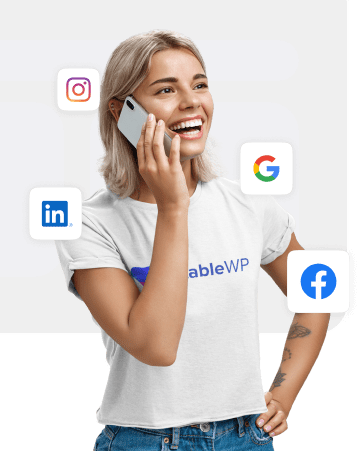Google Ads funnel is a powerful PPC strategy that will help extend the reach of your campaigns, attract new prospects for cheap, and make your conversions much more profitable.
While Google search ads remain to be a go-to strategy to capture users with high buying intent, relying solely on them can prove to be flawed.
You’re likely missing out on a much bigger pool of potential customers that aren’t actively searching for your product/service but still may be interested in buying from you.
Also, only using Google search ads to target only high buying intent keywords can get pretty competitive and expensive.
That’s why our Google Ads funnel strategy aims to attract new users, generate demand, and fill your sales funnel with quality prospects. So, when they’re ready to pull the trigger and sign up or buy, it’ll be much easier to turn them into profitable customers.
In this guide, you’ll learn the ins and outs of the Google Ads funnel strategy and how to build a full PPC funnel campaign to maximize your advertising ROI.
TL; DR: If you want to jump straight to creating your perfect Optimal Google Ads campaign type for the TOFU stage Google Ads funnel, you can click here. Otherwise, let’s go over what a Google Ads funnel is and why it’s the most powerful PPC strategy.
Table of Contents
What is a Google Ads funnel
The Google Ads funnel is a strategy that uses a sequence of various campaigns that guide prospects through the buyer’s journey. It’s designed to attract complete strangers, generate interest and demand, warm-up prospects to actively start searching for your products/services and turn them into paying customers with targeted content and offers.
Too complex?! Well, think of it as a way to connect with prospective users with the right ad messaging and promotion at the right moment, to help turn them into leads and customers at scale.
The Google Ads funnel consists of three main stages:
- Top of the Funnel (TOFU) – Awareness stage
- Middle of the Funnel (MOFU) – Consideration stage
- Bottom of the Funnel (BOFU) – Conversion/Action stage

With a Google Ads funnel, you can target users with personalized messaging and relevant offers that resonate at each stage of the customer journey:
- Strangers (cold audience) – People unaware of your business, not actively searching for what you offer. Raise awareness and introduce your brand.
- Prospects (temperate audience) – Users exposed to your ads and content that start to realize their need for your products. Build interest and generate demand.
- Active Searchers (warm audience) – People actively searching for products or services that you offer. Encourage them to take action and convert.
- Leads (hot audience) – Highly interested users that shared their contact info with you. Nudge them to buy with persuasive ad messaging and special promos.
- Customers – People that buy your products or services.
At the Top of the Funnel (TOFU), Google Ads campaigns can help you reach completely new audiences. These are people that likely never heard of your brand before. They’re also not actively searching for what you offer.
What’s more, they might still not be aware that they need your product/service. Use Google Ads to attract these strangers into your funnel, gradually raise awareness and build interest with engaging content.
As cold audiences get exposed to your ads and content, they get inspired and start researching on Google. Initially, they may be searching for very broad, informational content, using “how-to” keywords.

While SEO can help your content rank high on Google organically, search ads can bring much faster results.
The more prospects learn, the more they define their needs and start searching for specific search terms, transitioning to the Middle of the Funnel. You can capture these users with MOFU search ads and drive them to your website.
This is a decisive step since a visit to your website adds them to your remarketing database.
Now you can continue using personalized remarketing campaigns to drive action based on the pages they visit or their interactions with your site.
From this point on, you’ll want to use targeted Google Ads to push people to sign up for your email list and ultimately become customers.
A typical customer journey may look like this; however, sometimes certain steps or even entire stages are skipped.
For instance, some users may immediately start searching for specific products/services. In that case, use Google search ads to capture these hot audiences with high buying intent.
Also, depending on your business model, you may want to use Google Ads to drive leads or sales. So, your specific PPC funnel strategy will vary. Still, these are the underlying fundamentals that comprise a strong and effective Google Ads strategy that maximizes your advertising returns.
Let’s quickly go over why you need a Google Ads funnel and what makes it such a powerful PPC strategy.
Why a Google Ads funnel is the best PPC strategy
Google Ads remains the leading advertising platform to generate leads and sales. It works perfectly for direct response marketing where you want to drive people to take action and convert on your offers.
Google’s core campaign type is the search ads that can help you capture the hottest prospects as they google things related to your products/service. What makes them so effective is the ability to target users with high buying intent based on the keywords they use.

As powerful as Google search campaigns are, relying solely on them has three main issues.
For one, search campaigns work well when there’s a high demand for your product/service.
However, if there’s not enough search volume, such as if you’re in a very niche market or if you offer something completely new and disruptive, you may be missing out.
There could be a huge potential market that you’re not reaching. People may be interested in buying from you, it’s just that they may not be actively googling your keywords.
In that case, Google Ads funnel can help connect with more prospects that could be interested in your offerings with upper-funnel campaigns. With a good combination of ad messaging and content, you can introduce your brand to completely new audiences and generate demand.
Secondly, since these search campaigns and keywords are super-targeted, they attract all your competitors. And more competition drives up ad costs, making some Bottom of the Funnel keywords cost $10, $20 and even $50 per click.

With a Google Ads funnel, you can aim to capture these users in earlier stages, when the ad cost is much lower.
The cost of Display and Video ads are less than a $1, often being as low as $0.2-$0.4 in accounts we manage.
So, you can build a remarketing database for very cheap and gradually guide users to become leads and customers. This leads to profitable campaigns and a much higher ROI.
Which leads us to the final issue…
Many people may be hesitant to sign up for an email list or buy from a brand they’ve never seen before.
No matter how good your keyword targeting is or how tempting your offer may be, people don’t want to buy from strangers.
A Google Ads funnel eliminates this issue by introducing your brand through multiple touchpoints along the buyer’s journey.
So, when a prospect is ready to take action and buy, they’ll be more likely to convert on your offers.
Now that you understand why you need it, let me show you how to build your perfect Google Ads funnel.
How to create a Google Ads funnel
Building a perfect Google Ads funnel is the process of mapping out and configuring ad campaigns for each step of the customer journey.
There are 4 main factors that lead to successful Google Ads:
- Using the right campaign type
- Optimal targeting
- Relevant offers that resonate at each stage
- Bidding strategies that efficiently use your budget
We’ll cover each of these elements to help you create the most effective Google Ads campaigns that result in profitable customers and maximize your ROI.
Let’s get started with attracting cold prospects with Top of the Funnel campaigns.
3X Your Business in 90 Days
Get an unfair advantage with our powerful 3-step funnel strategy and learn how to increase leads and sales by 300% fast.
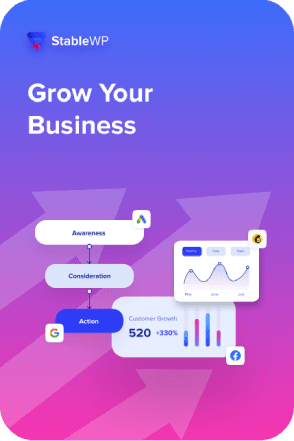
Stage 1: TOFU – Raise awareness and attract cold audiences
Google Ads Top of the Funnel campaigns is designed to introduce your brand to new, cold audiences who aren’t familiar with you yet.
The main idea is to get your brand in front of strangers that could potentially become your customers.
Cold prospects typically won’t be searching for your business or products. They might not be even aware that you exist or that they even need what you offer.
That’s why display and video campaigns work great to grab attention and capture users’ interest at the upper-funnel stage.

You can still use search campaigns in the TOFU phase. However, people at this stage are just starting to realize they may have a problem and their searches will be focused on learning more about the issue.

You should also consider that most users aren’t ready for a big commitment and won’t buy from you yet. So, your TOFU goal should be to prime these prospects by gradually building interest and generating demand.
Be sure to align your ad messaging and offers to provide informational and educational content instead of pushing sales or other high commitment asks.
Focus on introducing your brand by educating users about the solution to their problems, putting the “life-changing” benefits of your products/service front and center.

And, since this stage won’t directly bring much revenue, you should aim to attract users at a low cost.
That’s why you should focus on campaign types and bidding strategies that result in cheaper CPCs and attract a high volume of prospects.
a) Optimal Google Ads campaign type for the TOFU stage
Google Ads campaign types that can help you reach a broad audience and raise awareness in the TOFU stage are:
- Display campaigns
- Video campaigns
- Discovery ads
- Search campaigns
1. TOFU Display ad campaigns
Google Display ads are a great way to attract new traffic and prospects – event when they’re not searching for you.
The main purpose of Display Ads is to raise awareness and get your brand exposed to completely new audiences that are not familiar with what you do.

The idea is to reach as many people possible, across the internet and not just on Google.
Display Ads are shown on the Google Display Network (GDN) which is a group of more than 2 million websites, videos, and apps reaching over 90% of Internet users worldwide (according to Google).
An easy way to start with Display advertising on Google is to use Responsive Display ads.
It’s an automated ad type that allows you to upload assets including 15 images, 5 logos, 5 headlines, and 5 descriptions. These assets are then mixed and matched to fit and meet the requirements of any website or app in Google’s Display Network (GDN).
Plus, Google is going to automatically optimize your ads to show the highest performing combination to help you get the best results.
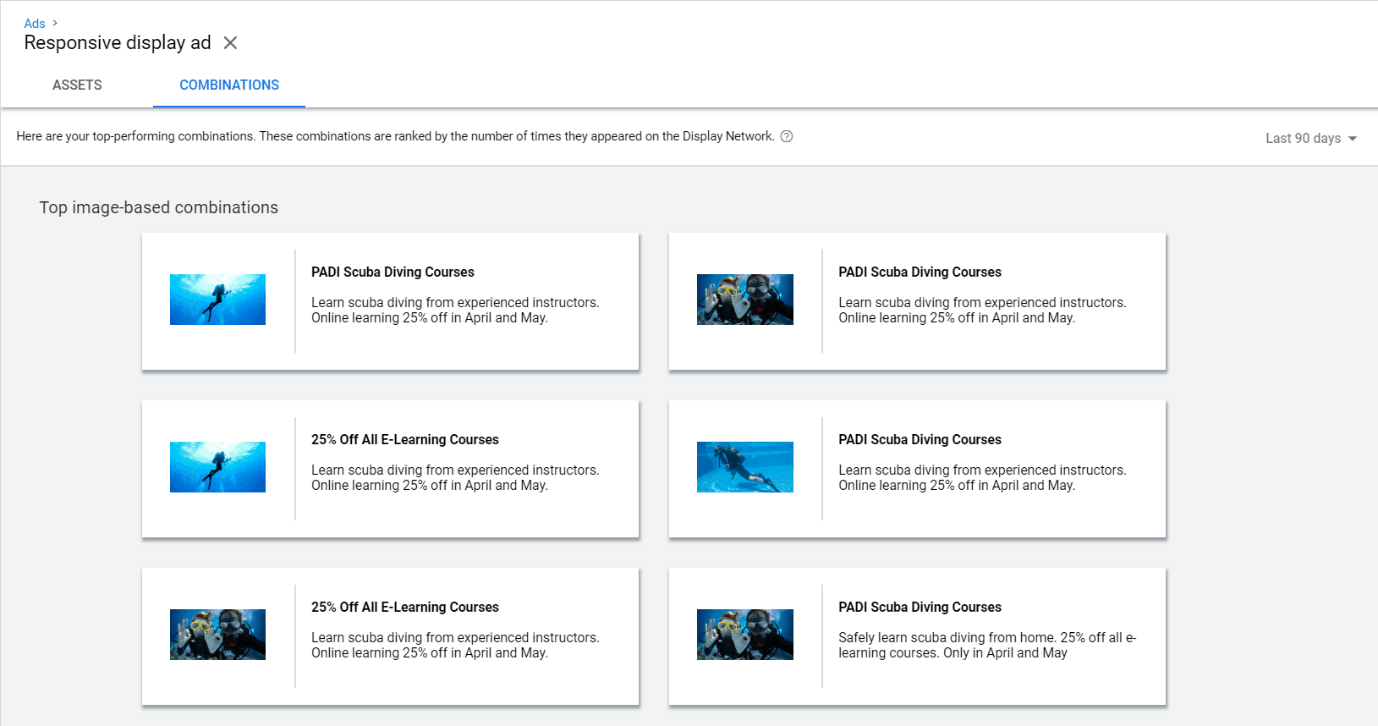
So, no longer will you have to make dozens of ad images every month to promote your business on GDN.
2. TOFU Video campaigns
Video campaigns are a highly effective way to capture the attention of cold prospects for the TOFU stage of your PPC funnel. Google’s video ads appear on YouTube across all devices.
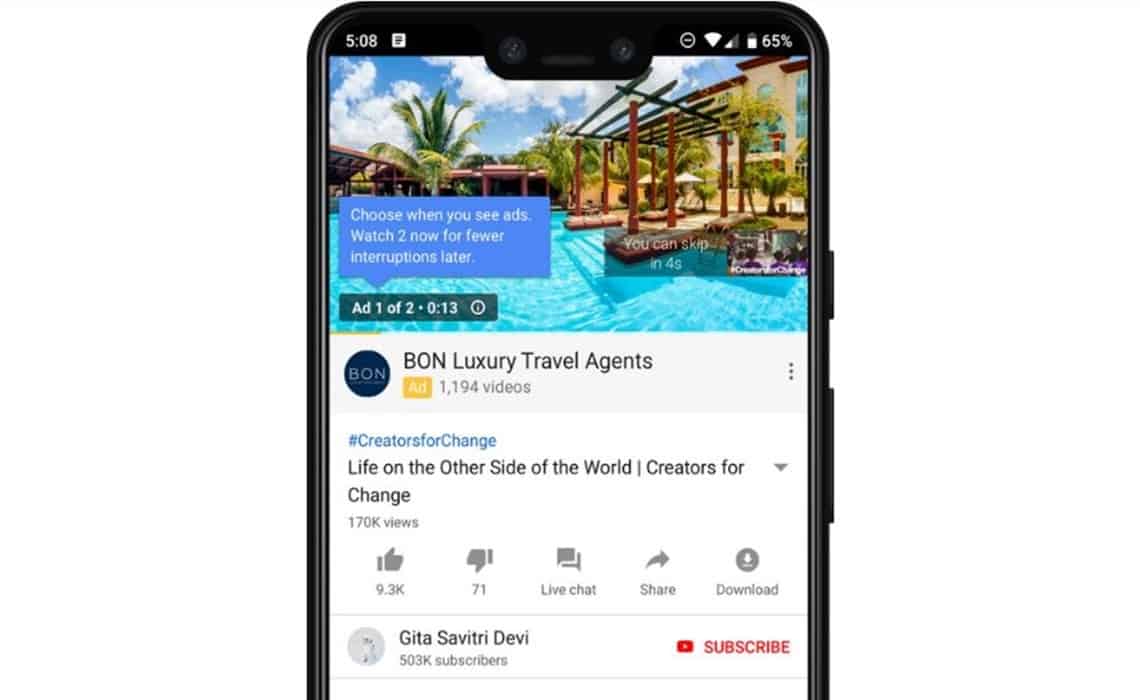
Video ads are a great way to drive awareness by providing context and visuals in a way that text or image ads can’t. They work especially well as an initial touchpoint to introduce your business to new audiences unfamiliar with your brand.
Well-targeted video ads not only earn views, but they can also bring new engaged prospects to your landing page or website.
TOFU video ads are designed to introduce people to your offering with interesting, attention-grabbing content while showing what your products can do.
Use TrueView ads that play before relevant YouTube videos. They allow users to skip after 5 seconds.
What’s best, you only pay when viewers watch for at least 30 seconds or until the end of the video, whichever comes first.
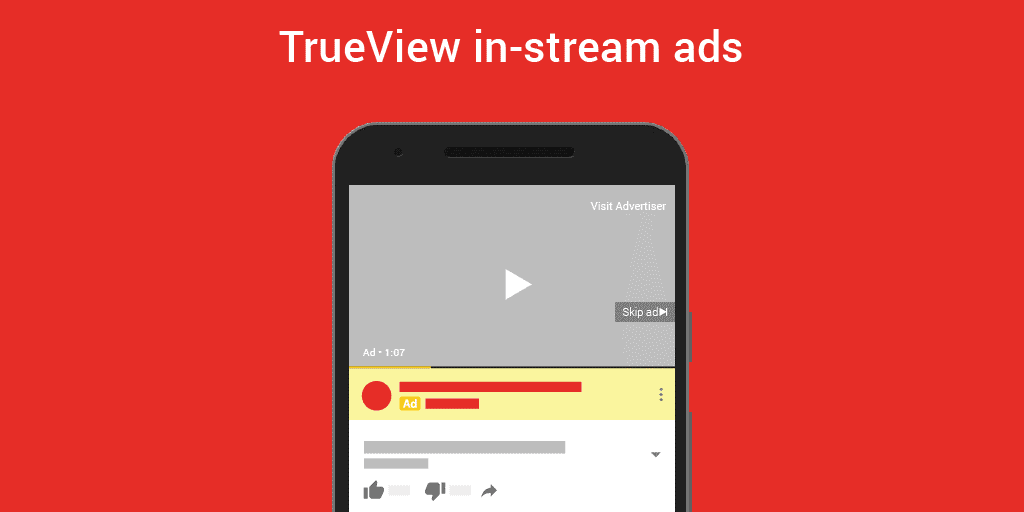
TrueView video ads work great for the TOFU stage since they appear before videos your target audience is interested in. This is when they’re most engaged and pay the most attention.
And if manage to keep users interested, you’re likely to leave a strong impression and make your offer memorable which is, after all, the goal with cold audiences.
On the other hand, even if people skip, you might still be able to raise some brand awareness and you won’t have to pay for the ad.
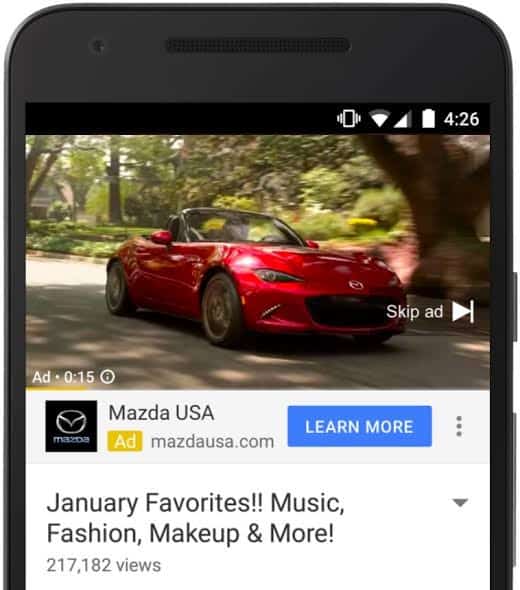
The final benefit of using video ads for your TOFU PPC campaigns is that you can remarket people based on video views in the later stages of your funnel.
3. TOFU Discovery ads
Google Discover is becoming more and more popular with a reported 800 million users clocking in on the regular.
Similar to social media news feeds, Google Discover serves relevant content to users based on their interests and browsing history.
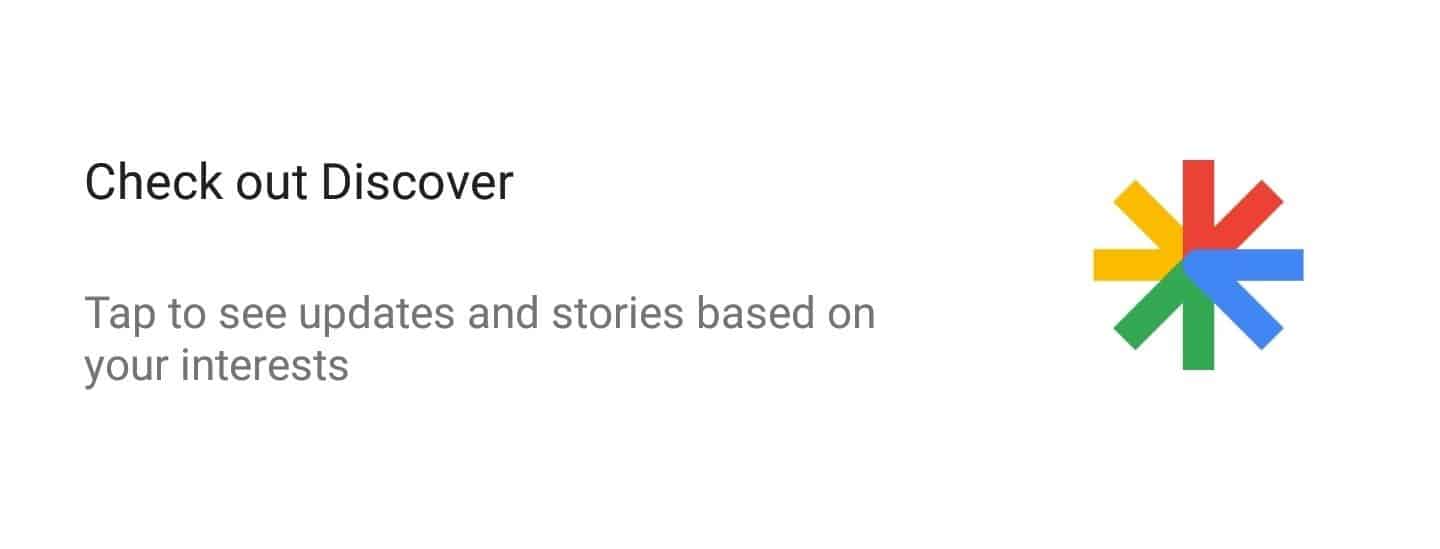
Discovery ads, as the name implies, help your business get discovered by new audiences that are likely to be interested in what you offer.
Google Discovery ads appear in the Google mobile app, YouTube as well as Gmail.
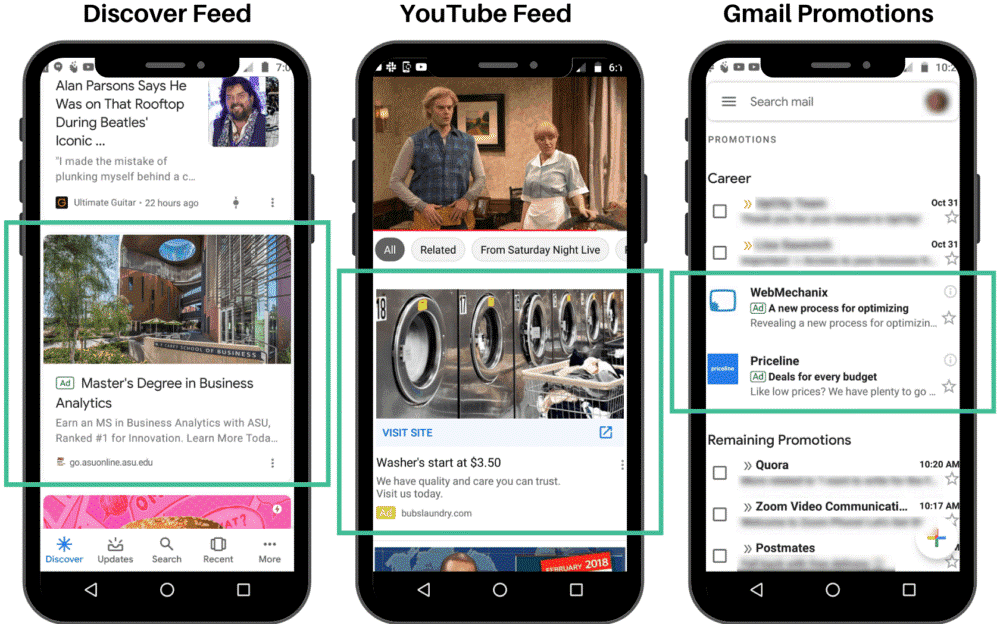
With Google Discovery ads you can reach targeted users based on their activity and interests. It’s a powerful way to connect with cold prospects in the TOFU funnel stage.
They look similar to ads you’d see on Facebook, Instagram or LinkedIn, with images, headlines and calls-to-action.
With visually rich Discovery ads, you drive interest from potential customers at the right moment when they’re likely to be open to trying new brands or products.
TOFU audience targeting for Display, Video and Discovery campaigns
Display, Video and Discovery ads all share the same targeting principal based on audiences. Essentially, you pick an audience to target and tell Google to show your TOFU ads to users with those exact characteristics.
For the TOFU stage, it’s best to target audiences based on:
- Demographics
- Affinity (interests and habits)
- Life events
- Topic targeting
- Managed placements
- Custom Affinity audiences
Since your goal in the TOFU stage is to reach as many people as possible, you will likely want to set broad targeting. This means avoiding too many targeting layers that could reduce potential reach.
A typical starting point would be to set a combination of Location + Age + Gender + Affinity Audience.
For instance, you could be targeting women in Canada that are between 18-35 and are interested in beauty and fashion.
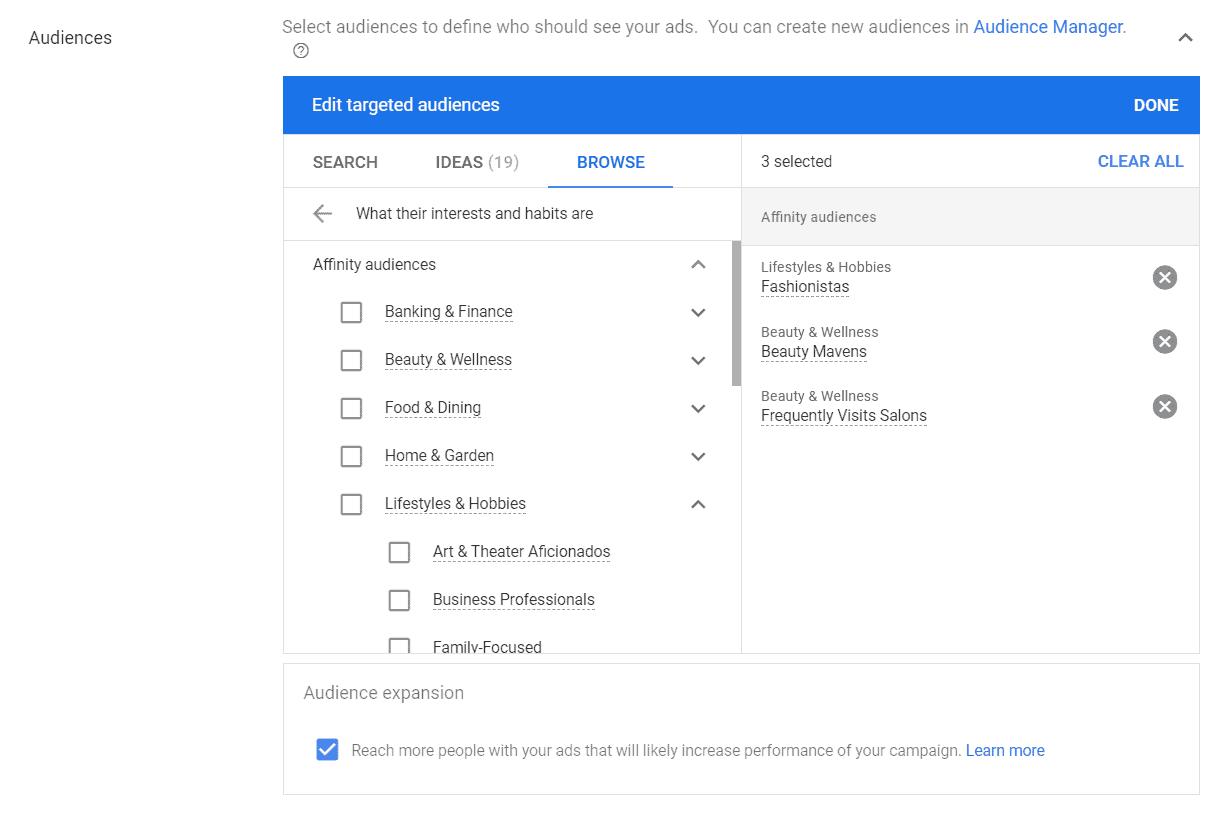
You can also use Custom Affinity audiences, which are a more refined version of the standard interest-based targeting.
To set up a Custom Affinity audience, you can stack different interests, URLs, places or apps that describe the audience you want to target.
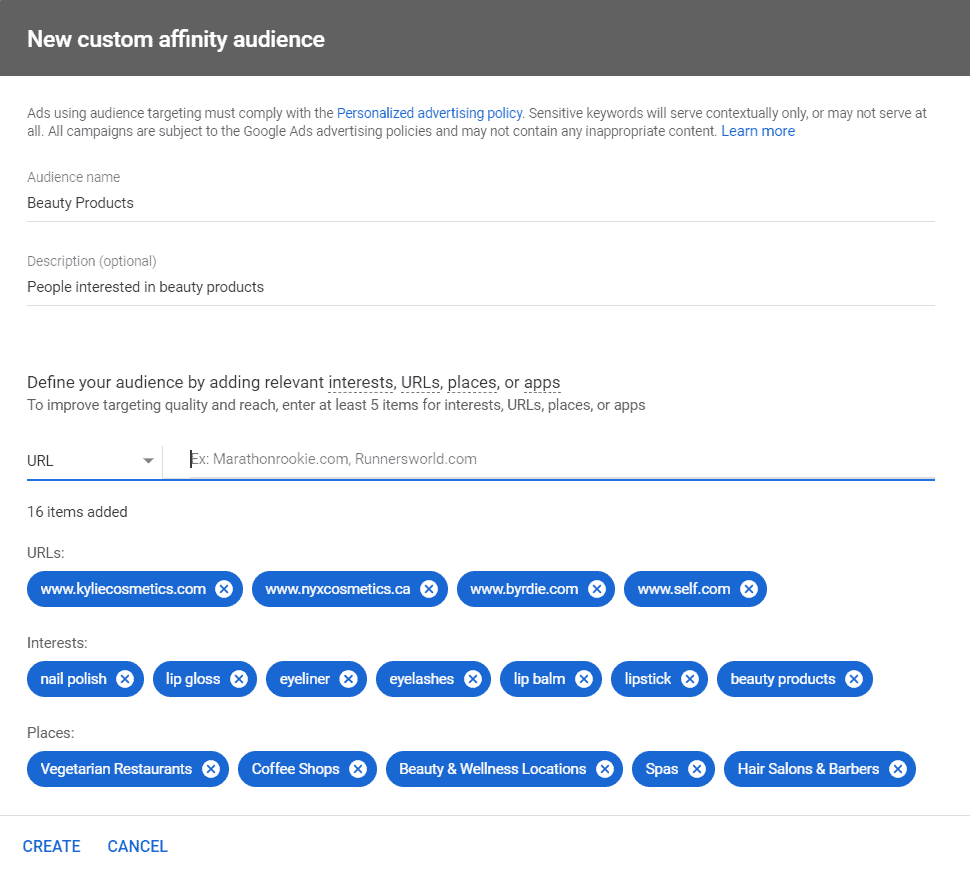
In our example, a Custom Affinity audience is interested in things like nail polish, lip gloss and eyeliner. They also frequently visit spas, vegetarian restaurants and beauty & wellness locations, and often browse popular beauty product websites.
You can also experiment with Managed Placements to control the websites your ads are placed on. This gives you the option to only target specific websites you believe are relevant and popular with your target audience.
This can also work with Video ad campaigns, where you can set ads to only appear on specific YouTube videos and channels.
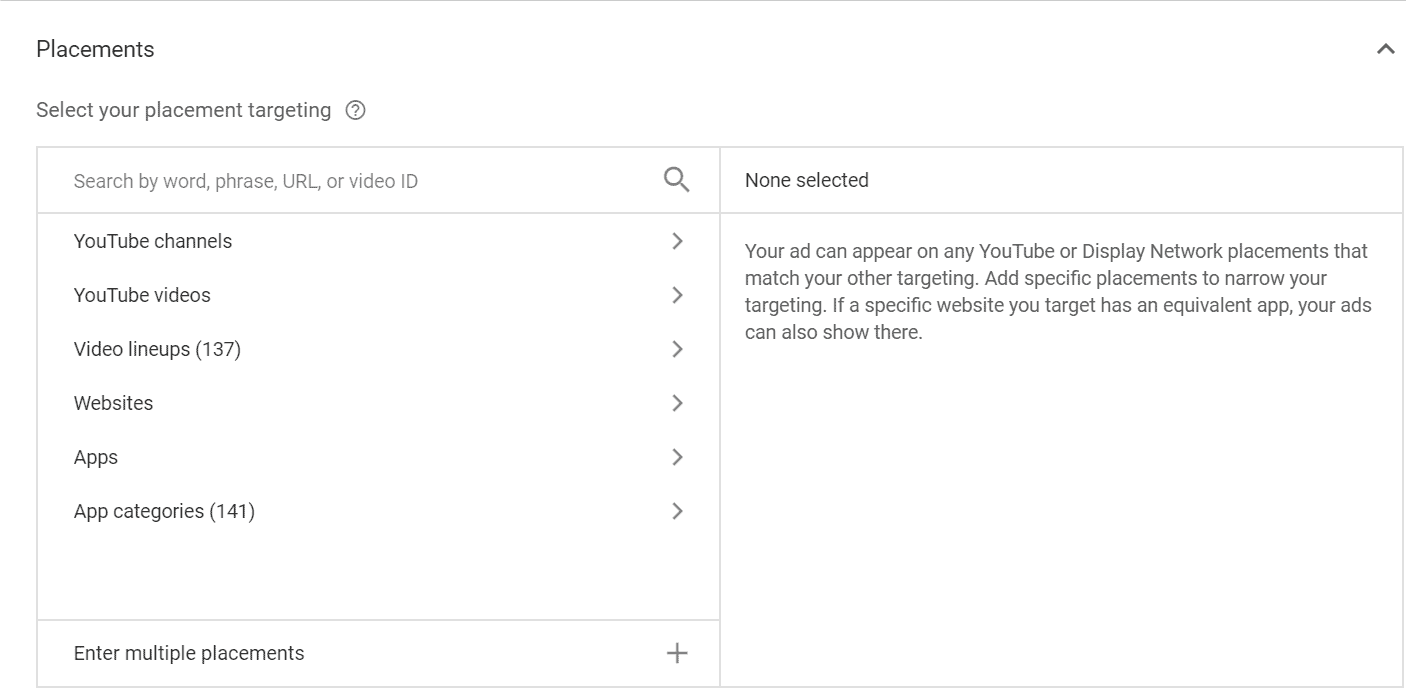
Finally, Topic and Keyword targeting allows you to reach a broader audience than Managed Placements.
It’s a good way to achieve contextual targeting and have your ads appear on websites and videos your potential customers might browse.
4. TOFU Search campaigns
Getting prospects to enter your funnel is the first step to a sale, which is why Top of the Funnel keywords play an important role.
Use TOFU search campaigns to reach users that are in the early stages of their research.
By connecting your product/service with typical questions or problems a prospective customer may have, you can introduce your brand and frame your offerings as a possible solution.
This could be targeting people that search for information, ask questions or research a problem they’re having.
The idea is to target broad search terms or early research keywords to expose your brand to a massive audience of people.
There would be thousands or millions of people searching for common problem terms like “pimples on the back” then, for example, “Neutrogena body wash.” So, there’s a huge potential market to advertise to.

And since there’s a lot more ad inventory for these keywords and they don’t generate revenue directly, there would be less competition.
This means you can attract new prospects for much cheaper than if you’d go straight for specific keywords with high buying intent.
Search campaign targeting for the Top of the Funnel
When setting up a PPC campaign to raise awareness for your product/service, you’ll want to target keywords that indicate someone is searching for information, or they are having a problem that your business can solve.
So, in the Awareness stage, you can target the following keyword types with your Google ads:
- Informational keywords
- How-to keywords
- Question oriented keywords
- Very broad product/service keywords
Question oriented keywords can indicate a user is in the early stages of research. This type of keyword targeting can help attract cold prospects into your Google Ads funnel.
Let’s take “can you cure sleep apnea” as an example.
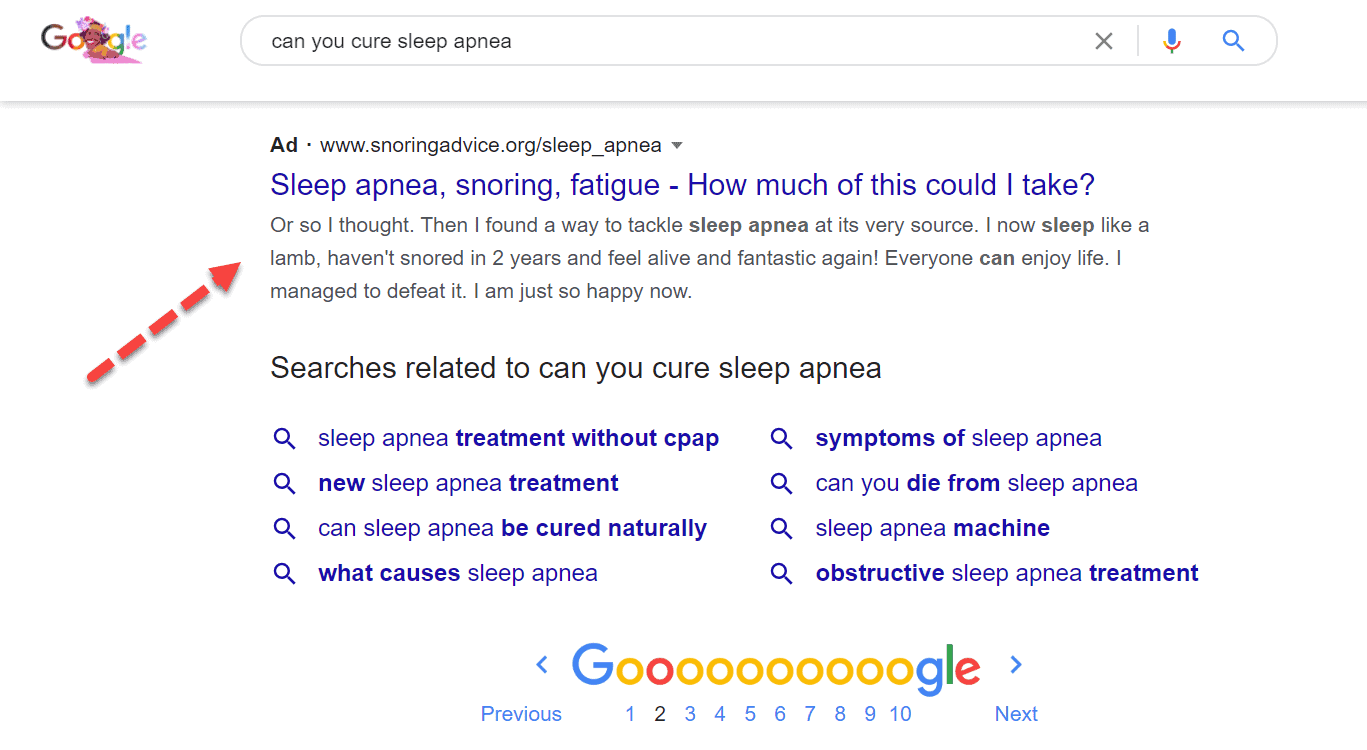
These keywords are far from generating revenue. That’s why most advertisers are not willing to bid high on such keywords and the ads typically appear on the bottom of the page.
However, even though they may not bring direct sales immediately, they’re worth bidding on. Question-based queries do help fill the top of your funnel with fresh prospects.
On the other hand, some “how-to” searches are so competitive that they not only yield regular search ads but shopping ads as well (which is another Google Ads product that deserves a guide of its own).
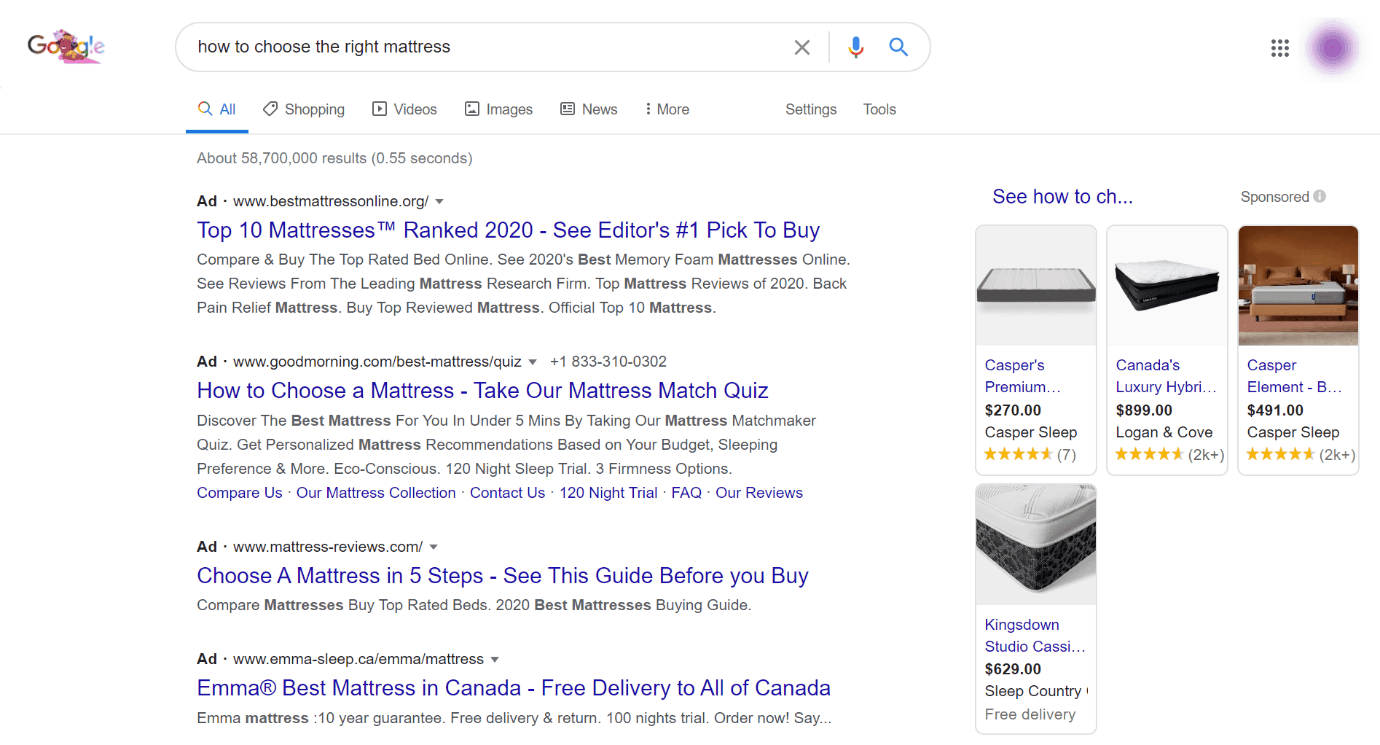
Relevant “how-to” and informational keywords can bring a ton of quality prospects for further nurturing.
Very broad product/service keywords also indicate a user is in the early stages of research. Since they’re too broad, it’s hard to pinpoint the exact intent.
A person searching for “patio décor” could be looking to buy a product, but they could also be just checking out images or browsing for ideas (upper funnel).
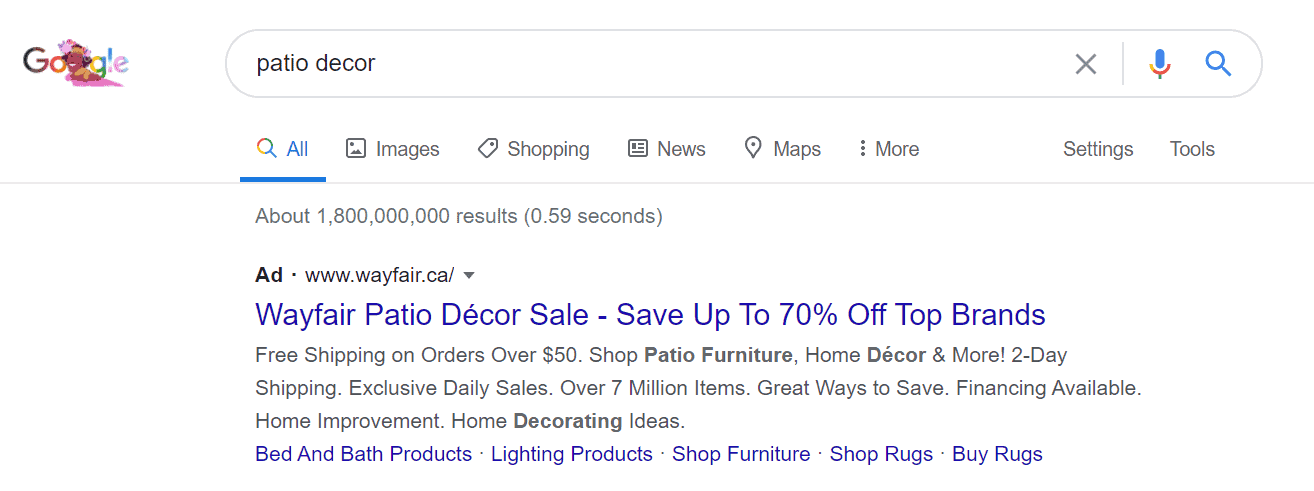
This type of broad search can point to various search intents. That’s why they belong to the TOFU campaign segment.
And for most of these searches, you’ll see a bunch of different Google results, from ads and organically ranked retailers, to images, videos, ideas, etc.
Even so, it’s worth targeting even such broad keywords since you can reach relevant audiences interested in what you offer.
Plus, it typically costs less to get these clicks and users into your funnel.
b) The perfect content and offer for cold audiences
When building out your Top of the Funnel PPC campaigns, you need to understand that TOFU is all about awareness, not driving leads and sales.
People at this stage are unaware of your product and service, so your campaign goals should be branding and education.
Your ad messaging should also reflect the educational and informational part of the strategy. Focus on using TOFU ads to introduce the unique selling proposition and connect it to a problem you solve for the prospects.
You also need to make sure you have landing pages within your website built specifically to handle this. These could be blog posts, downloadable PDFs or informative product/category pages on your e-commerce site.
Some good examples of a TOFU stage offer include getting users to:
- Watch a video
- Visit your website
- Take a quiz or a free assessment
- Check out your product page
- Read a blog post or a guide, etc.
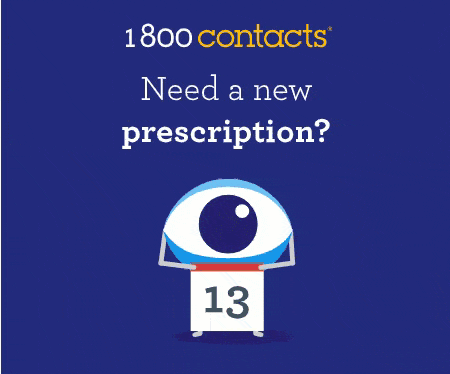
Most TOFU prospects won’t be ready to hop on a sales call with you. However, they may be interested in signing up for a free ebook or a virtual evaluation (like in the example above).
Use your Top of the Funnel ads to grab attention and spark curiosity to make your brand memorable in the eyes of potential customers.
c) Best Google Ads bidding strategies for TOFU
Cold prospects at the top of your Google Ads funnel are far from converting and generating any revenue for your business. The goal is to raise awareness and build some interest and demand.
However, since these goals have relatively low business value, you should also restrict bids at this stage to fill your PPC funnel with quality prospects at a low cost.
The following are the best bidding strategies for the TOFU stage:
- Manual CPC
- Max Clicks
- Max CPV (for Video campaigns)
- Max Conversions/Target CPA (only for Discovery ads)
Max Clicks is an automated bidding strategy. Google will look to drive the most clicks possible with your daily budget.
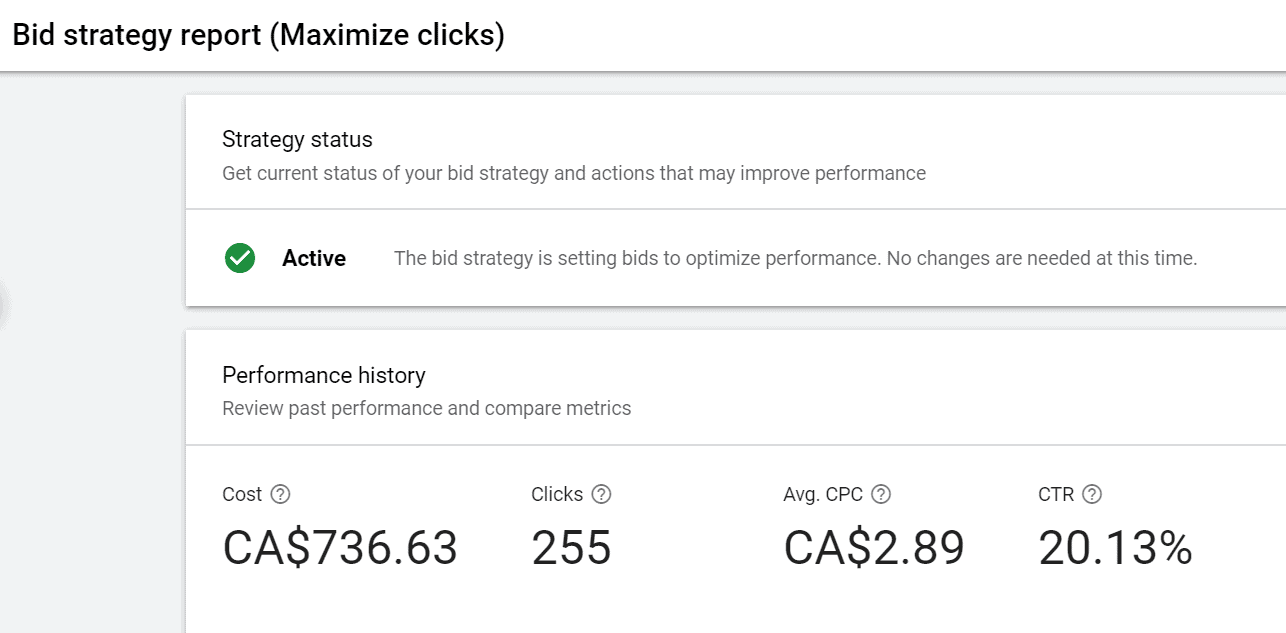
It works great for driving cold traffic to your website or landing pages since it targets users that are most likely to click through your ads.
Max Clicks is available for search and display ads.
For video campaigns, Max CPV (cost per view) will get the best results paired with TrueView ads.

It allows you to set a maximum amount you’re willing to pay per each view. And you only pay once a user watches the video ad for 30 seconds or clicks through.
For example, if you set your Max CPV to $0.25, you only pay a maximum of 25 cents when a user watches your ad or engages with your call to action.
This way you reduce the risk of running bad video ads that don’t get noticed or don’t result in visits to your website.
Discovery ads are limited to using only Max Conversions or Target CPA bidding strategies.
This may not be the ideal solution for cold audiences since it can be hard to make them convert. However, it can work pretty well if you’re using Discovery ads to drive people to a landing page to download a brochure or ebook.
If you’re not sure what CPA to set as your target, you can follow Google’s recommendation typically available in the setup screen.
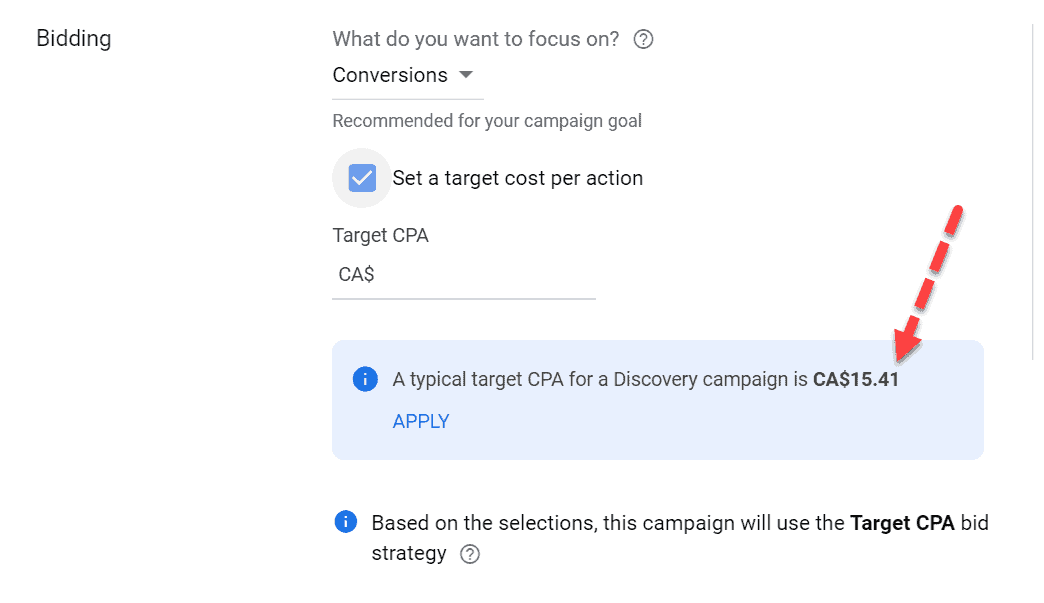
Finally, Manual CPC works well if you want to have granular control over bidding. This does mean spending more time monitoring costs and adjusting bids on your own.
Stage 2: MOFU – Drive consideration with warm audiences
The goal of your Middle of the Funnel PPC campaigns is to try and capture warmer audiences or people that are in the research and consideration parts of the buyer’s journey.
Users you want to target in this stage fall into one of these two groups:
- People exposed to your ads in the previous stage (that haven’t converted yet)
- People that started researching solutions on Google
So, either your TOFU ads sparked interest and got the users to this stage, or they realized the need for a solution and started researching on their own.
Whatever the case may be, your BOFU Google Ads campaigns can capture warm audiences at this stage and pull them deeper into the funnel.
For prospects already exposed to your brand, use remarketing campaigns to remind them of your products/services and focus attention on features and benefits, as well as how you compare to others.
In the case of users that search on Google but haven’t interacted with you yet, use search campaigns to target generic product/service keywords related to your business.
For example, instead of “how to cook a meal at home” which would be a TOFU keyword, in the MOFU stage you can target people that know that they want food delivery and search for “home cooked meals delivered.”
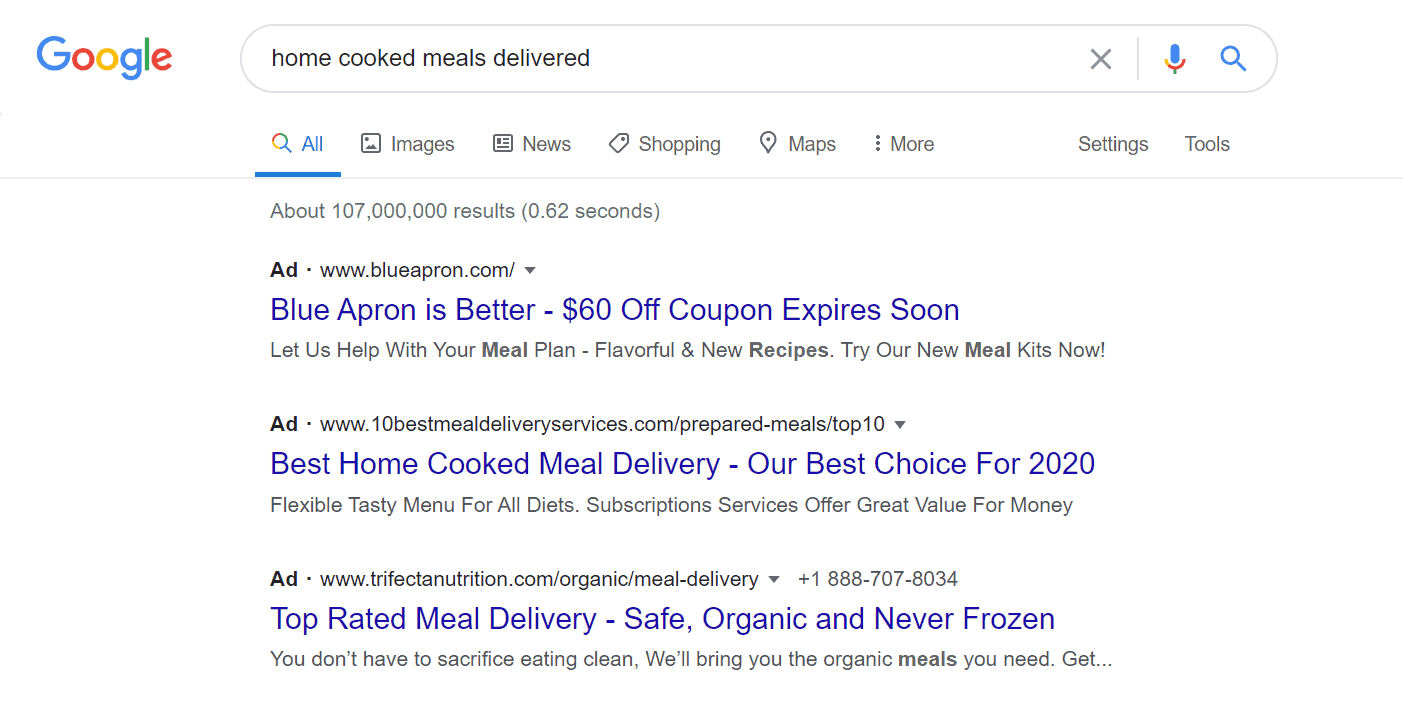
You can start to focus more on product/service specific and promotional ad messaging.
The MOFU stage of your PPC funnel is still too early to start selling and pushing for 1:1 calls with your sales reps. However, since these users are more interested and curious, you can go for higher-value conversions like lead form signups.
Turn prospects into leads by collecting their information for further nurturing.
a) Optimal Google Ads campaign type for the MOFU stage
Campaign types that perform best in the MOFU stage are:
- Search ads
- Remarketing campaigns (Video and Display)
- Intent-based display and video ads
1. MOFU Search campaigns
Google search ads play a vital role in the MOFU stage of your PPC funnel. At this point in the buyer’s journey, prospects have defined their needs and are actively researching a potential solution.
That’s why searches in the Consideration phase are more product- or service-oriented, as opposed to question- or problem-focused searches in the Awareness stage.
People are looking for solutions and weighing their options, so they’ll use more generic search terms that indicate a consideration intent.
This could be a generic product search like “canvas shoes for women.”
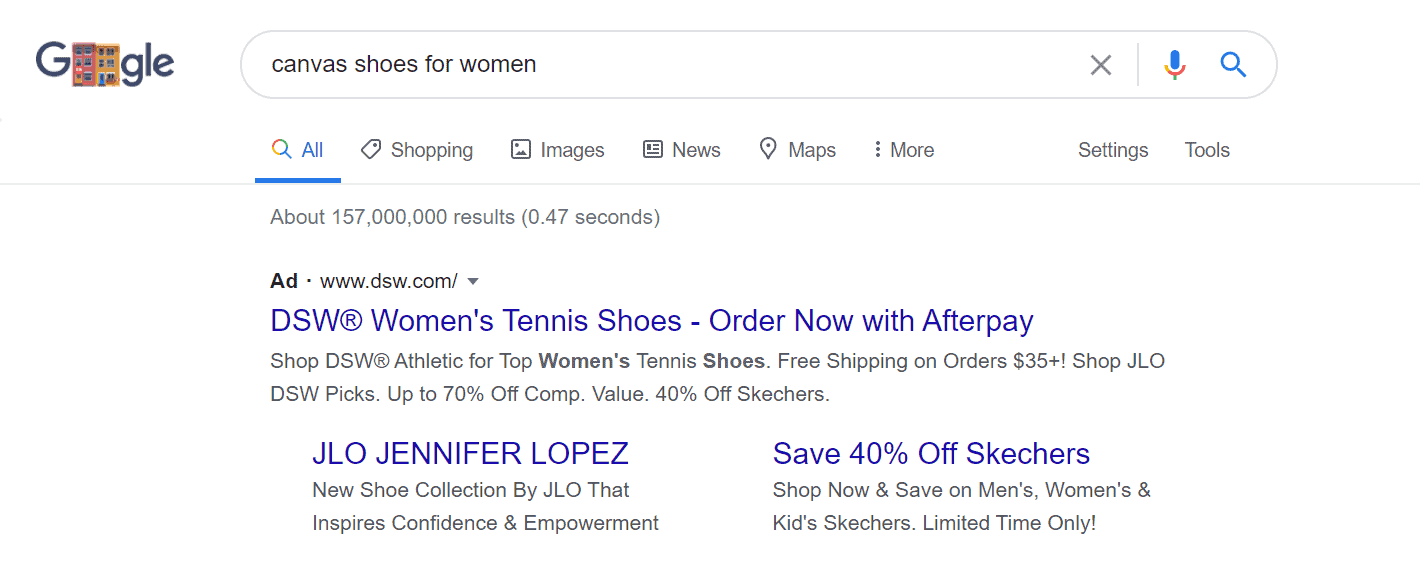
Warm audiences that search for your MOFU keywords are far more likely to take an action than prospects in the upper-funnel stage.
However, they’re still less likely to become a paying customer than those in the later stage. That’s why you’ll want to include promotions that drive people to check out your core offer, browse your products or sign up for a freebie like an ebook or white paper.
Search campaign targeting for the Middle of the Funnel
MOFU searches are more refined and solution-oriented. People at this stage are still reaching, but now they’re browsing options and comparing products, services and brands.
The best type of keywords to target in the MOFU stage are:
- General industry keywords (i.e. “private elementary school”)
- Generic product/service keywords (i.e. “shower enclosure”)
- Product category keywords (i.e. “pc gaming peripherals”)
- Comparison keywords (X vs Y)
General industry terms and generic product/service keywords indicate a user is interested in what you offer, however, the buying intent is still too weak.
Most users are looking at multiple adequate brands that could fulfill their needs, hence the Consideration name.
For example, someone searching for “basement renovation” is interested in this service.
However, they are most likely comparison shopping, looking for the right balance between price, quality and experience.
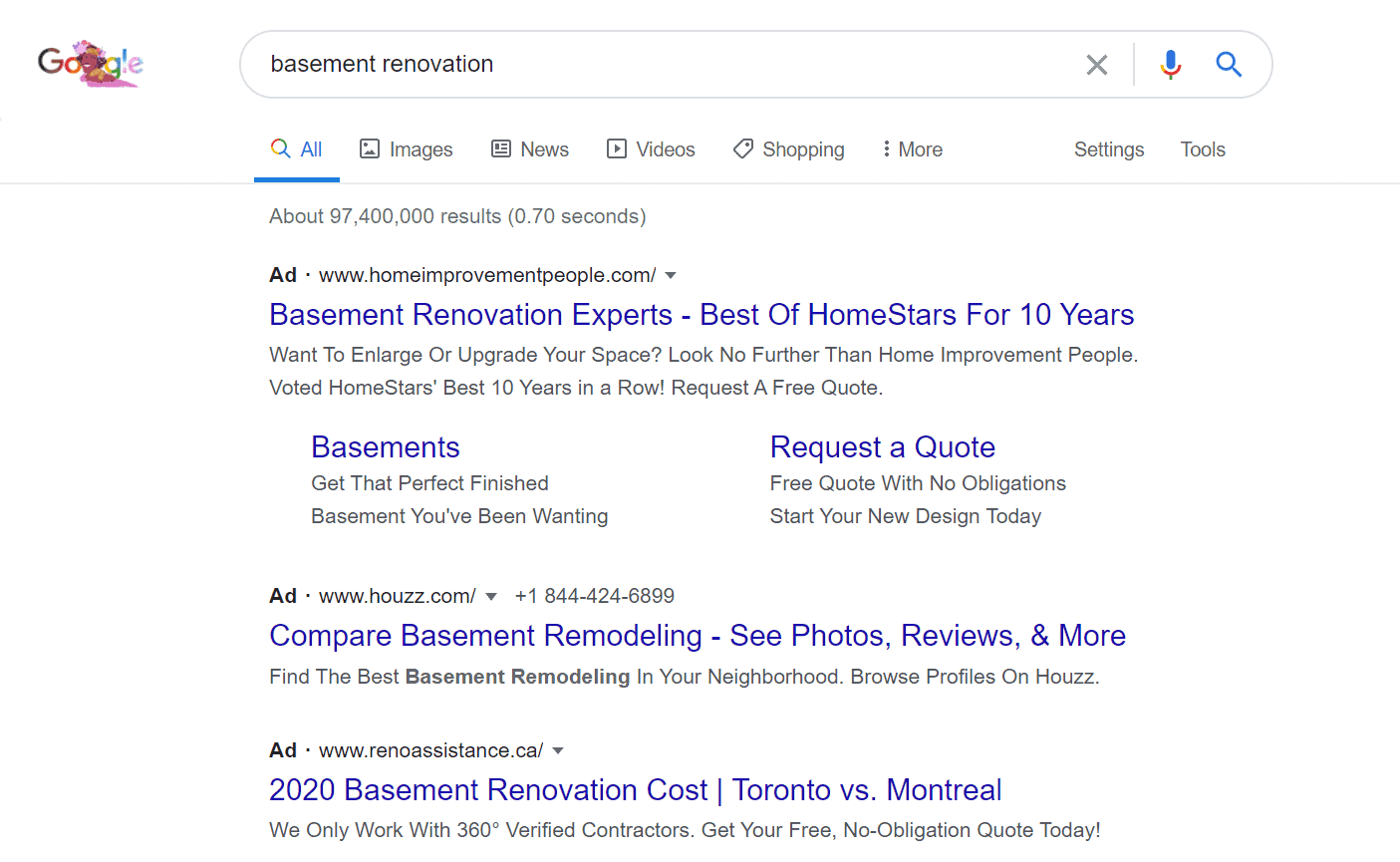
Product/service keywords indicate a slightly warmer audience that’s still in the research phase. A typical user is aware of what they need, they’re just looking at their options.
Let’s take someone searching for “shoes to relieve foot pain” as an example of the MOFU query.
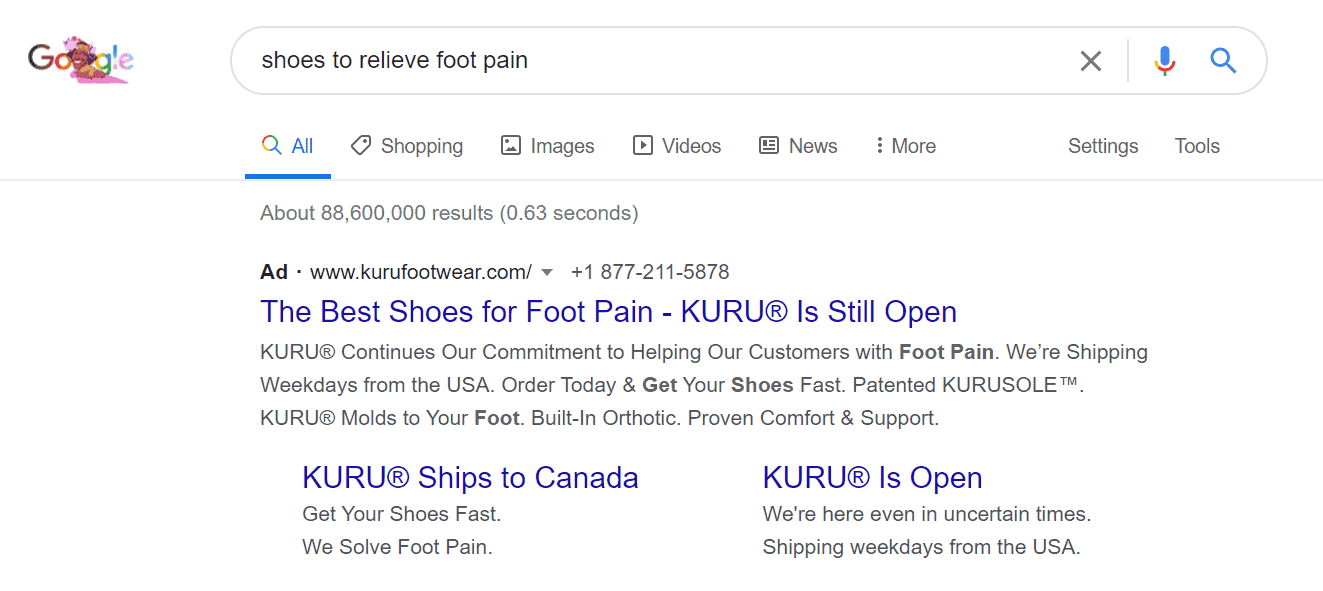
In this case, a prospect is aware that some shoes can help relieve foot pain, however, they’re far from being ready to buy. They’re still considering their options.
Same goes for product or service keywords that include the “best,” “top-rated” and other similar modifiers.
People at the MOFU stage are also comparing brands. That’s why a good keyword to target can be “X vs Y” or “X alternative.”
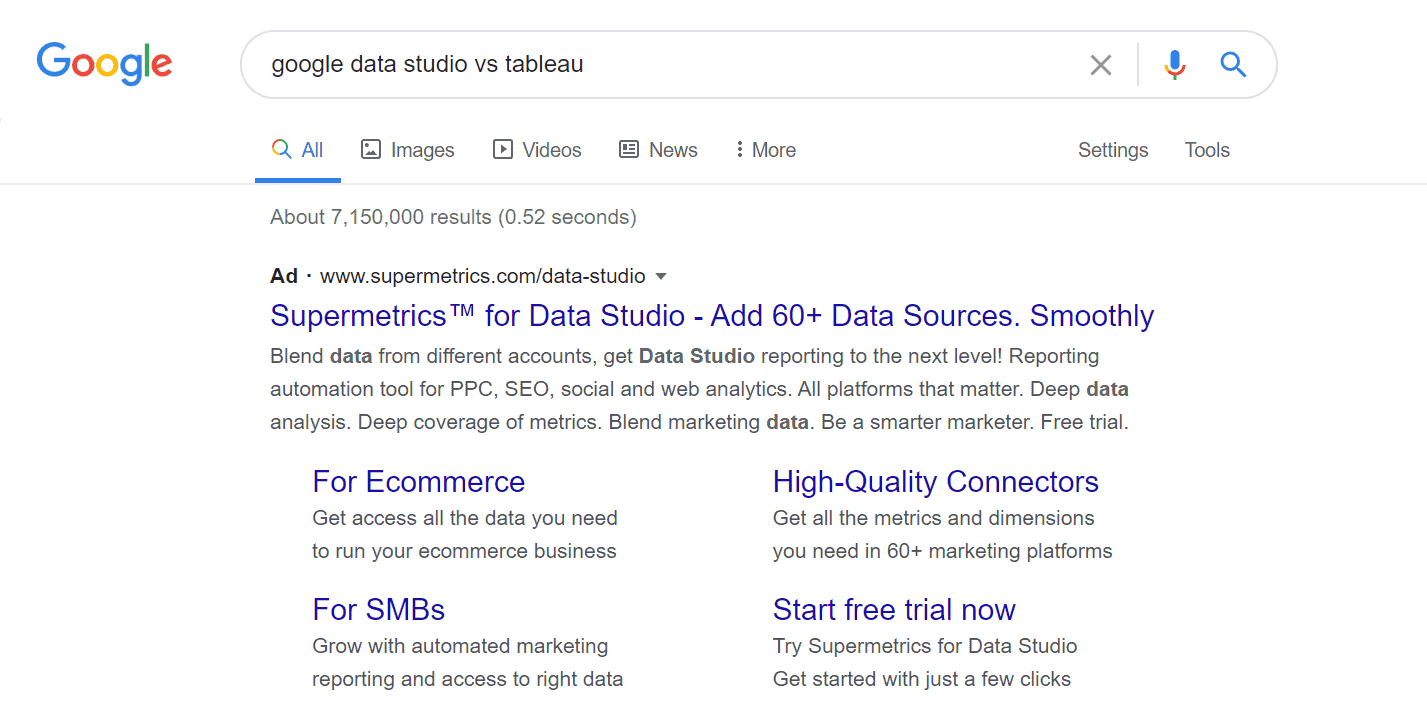
Someone comparing GDS and Tableau is likely interested in analytics reporting tools, which is the prime target for a company like Supermetrics.
Targeting these queries can help attract people in the Consideration stage into your Google Ads funnel.
2. MOFU Remarketing campaigns
In the Consideration stage, you want to retarget users that previously engaged with your website, business and video campaigns.
The goal of the previous stage was to attract cold audiences at scale for cheap.
If you’ve done everything correctly, your remarketing database should be full of new prospects that expressed some interest in your offerings.
Now it’s time to keep them moving to the next step. Use Google’s remarketing campaigns to generate a stronger interest and desire, and drive higher-value actions on your site.
For MOFU remarketing you can use both display and video campaigns.
The focus of your ad messaging is going to be different from your TOFU ads since the users are already somewhat familiar with your brand.
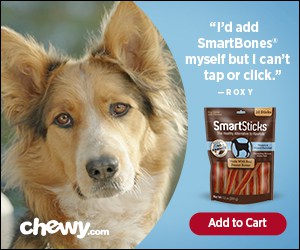
The attention should be on your products/services and their unique features, benefits and any proprietary technology that sets you apart from competitors.
Remarketing campaign targeting for the Middle of the Funnel
Warm leads that expressed interest in your product are a perfect fit for MOFU remarketing campaigns. They can fall into one of these groups:
- Website visitors
- Landing page visitors
- YouTube video viewers
A good way to start your MOFU remarketing is to target users that have visited your website or landing page but haven’t converted on your core offer.
These users could come from your ads in earlier stages, but they could also come from any other source including organic, referral or social media.
If you want to make sure you’re reaching engaged prospects and not just any visitors, you can also target only users that visited specific pages or those that have spent a certain amount of time on your website.
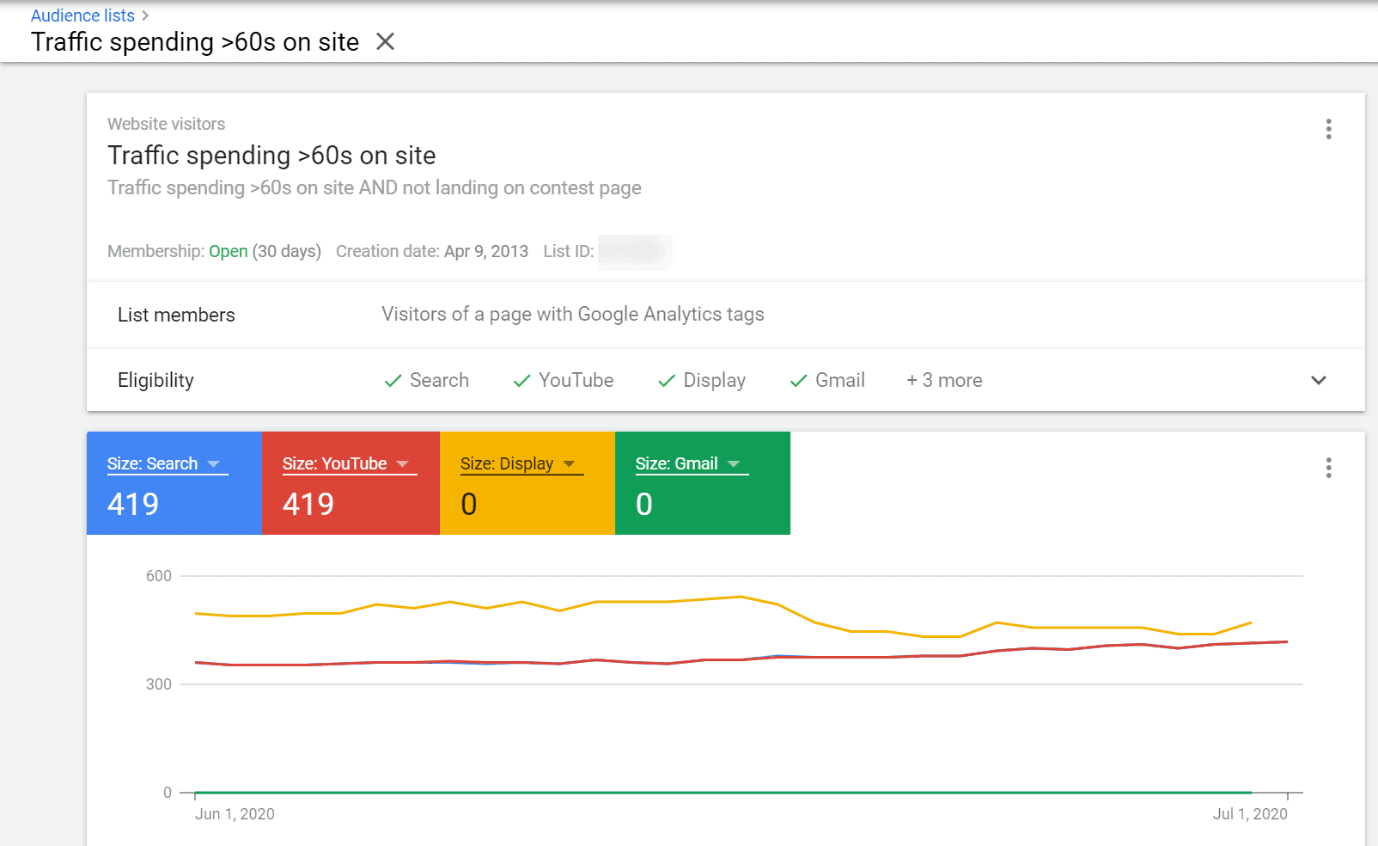
The key to remarketing is to exclude any users that have previously converted. Advertising to them would be a waste of money since they already reached the end of your funnel.

If you have a YouTube channel or run TOFU Video campaigns, you can also remarket to users that previously watched your videos.
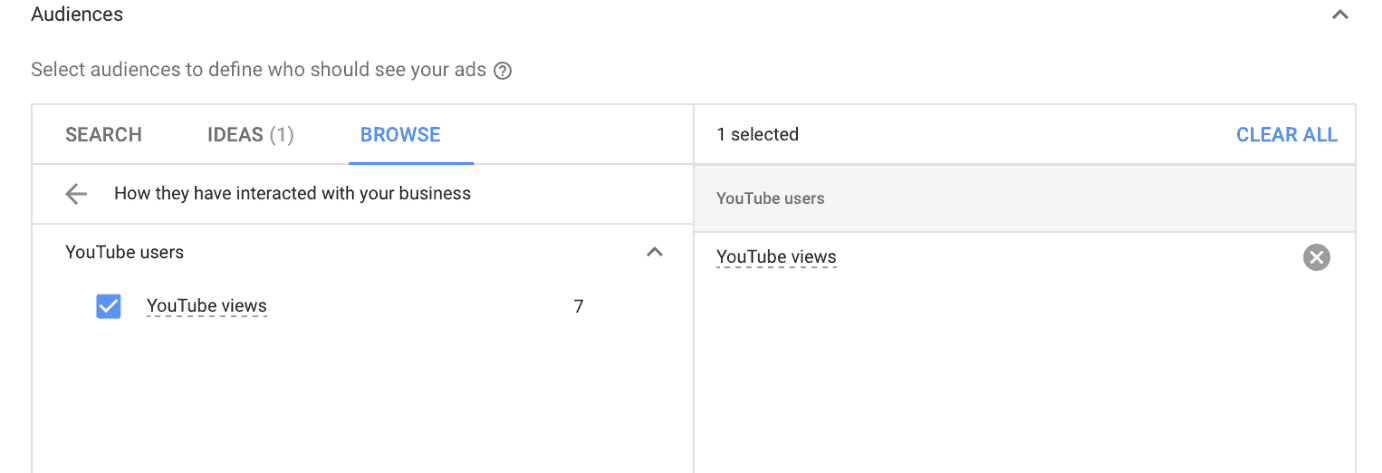
It’s an effective strategy to keep the momentum going and pull new prospects, that got to know you thought your videos, deeper into your PPC funnel.
4. MOFU Display and Video ads
In the MOFU stage, you can continue prospecting for new potential customers. Use display and video campaigns to target warm audiences that haven’t interacted with your business yet.
This way you can reach a whole new group of people that have shown some interest in what you offer, it’s just they haven’t had a chance to get exposed to your brand yet.
For your MOFU campaigns to work, you’ll want to set up a display and video targeting to reach people based on what they’re actively researching or planning.

Google has a lot of data that helps it understand user intent. So, when a person shows interest in a set of products or services based on the websites they visit, the content they watch or terms they google, it can match your ads with the right people at the right moment when they’re in the market for your products/service.
The reason why we segment these campaigns into different funnel stages is that at this step you’ll use different budgets and bidding compared to TOFU. The value of warm audiences in the MOFU stage is higher, so it makes sense to increase the bids and budget.
It also makes sense to test out different ad messaging and offers to match the audience’s temperature.
3X Your Business in 90 Days
Get an unfair advantage with our powerful 3-step funnel strategy and learn how to increase leads and sales by 300% fast.

Display and Video ad targeting for the Middle of the Funnel
There are three best audiences to use in the MOFU stage of your Google Ads funnel:
- In-market audiences
- Similar audiences
- Custom Intent audience
In the MOFU stage, you can experiment with prospecting for people that may not have interacted with your business but could be looking for your products.
For this, you can use Google’s In-market audiences to reach people who are actively researching, planning, and considering.
For example, a brand trying to reach new parents may set In-market audiences to target people looking at baby and children’s products.
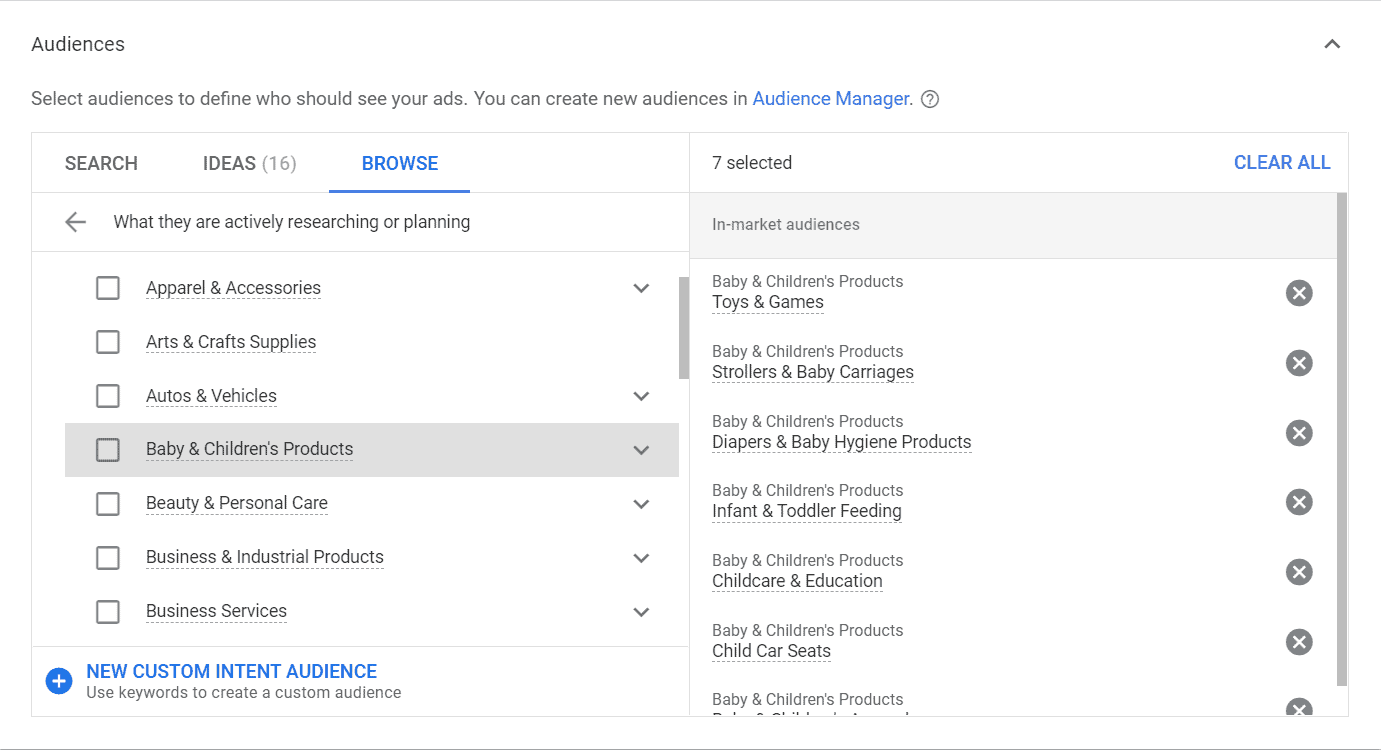
You can also test out Similar Audiences to show ads to people who share key characteristics with those on your existing remarketing lists.
Custom Intent audiences allow you to reach warm prospects with display and video campaigns based on keywords, apps, or YouTube content.
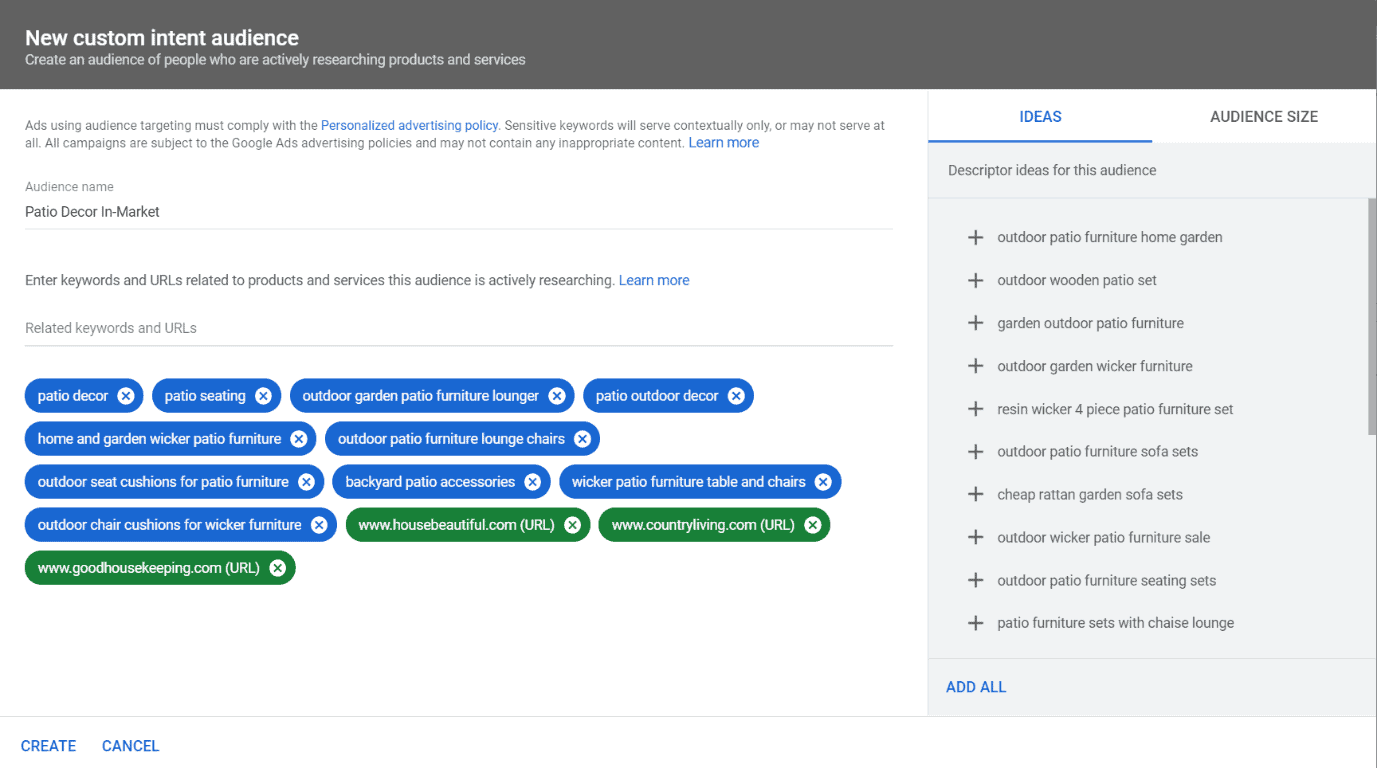
Custom Intent audiences can be auto-generated (by Google) or defined by entering keywords, content and apps related to your product or service.
The main difference between Custom Intent and Custom Affinity (from earlier) is that the Affinity audiences are based on interests and habits, which are broader and further from conversion.
However, Intent audiences are more defined and based on what a user is in market for. This indicates they are warmer and closer to making a decision which also makes them perfect for the Middle of the Funnel campaigns.
b) The perfect content and offer for warm audiences
Warm audiences in the Consideration phase are more familiar with their needs. Prospects have clearly defined their problem and are looking for a solution by actively searching on Google.
You also already made the first contact with many of these users through TOFU ad campaigns.
In this stage, prospects are warmed up and highly interested in what you offer. You just have to give them a nudge to turn that interest into desire. It’s time to aim for bigger actions, like signups.
The following offers are optimal for the MOFU stage:
- Reports
- Ebooks
- Webinars
- White Papers
- Brochures
- Case Studies
- Demo
- Free trial

A good way to capture leads in the MOFU stage is to offer a free downloadable such as an ebook, white paper or a brochure.
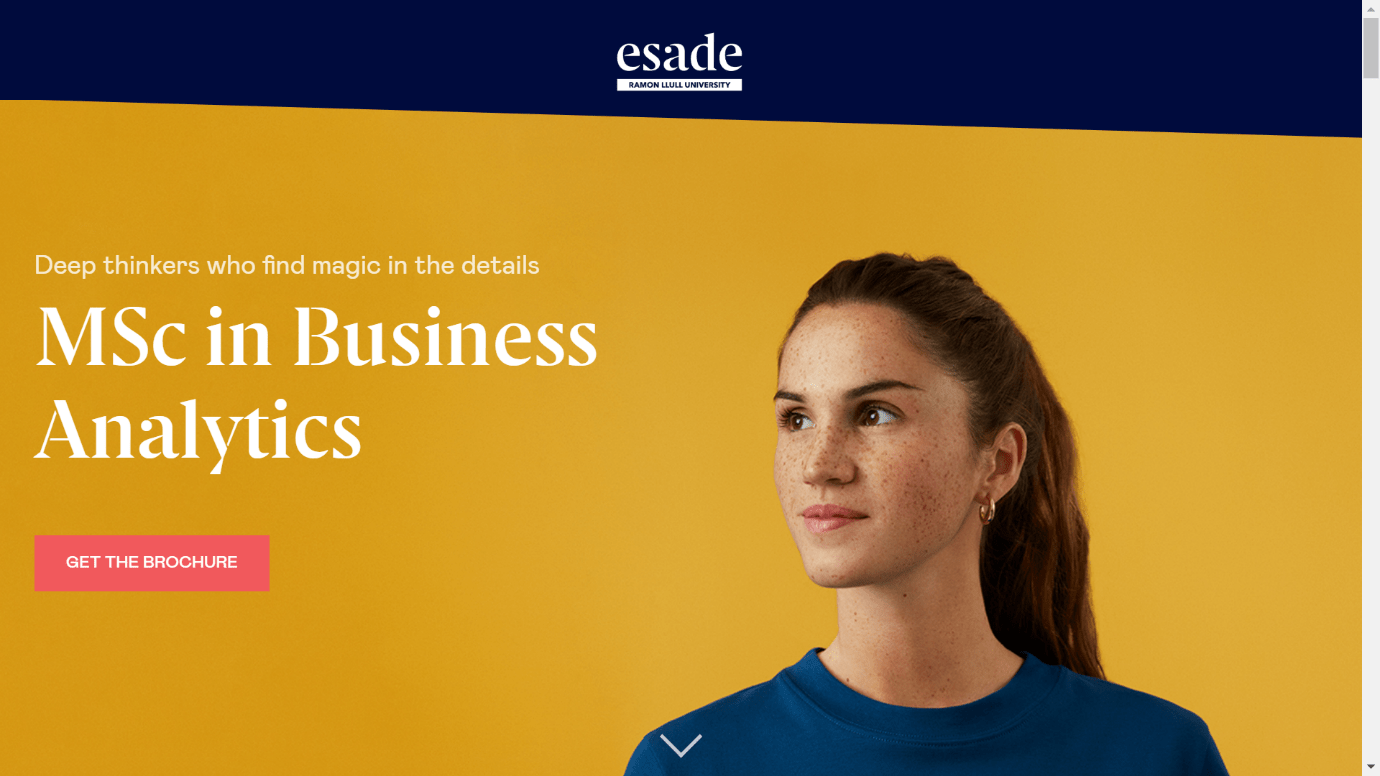
If you’re an e-commerce merchant, use Google Ads to drive more direct response and action, such as product views, adding products to cart or email signups.
Remember that at this stage your prospects are evaluating potential solutions, so make your ad copy and landing pages more specific, stating features and benefits as well as key differentiators.
Social proof can also work well to give a bit more confidence to prospects that they’re making the right decision.
Measure the success of your MOFU Google Ads campaigns by analyzing PDF downloads, webinar views, email signups, product page visits, adding products to cart, etc.
c) Best Google Ads bidding strategies for the MOFU stage
The main objective of your MOFU campaigns is not just to drive traffic but also to have those visitors take action on your website.
MOFU audiences are warm and closer to a conversion. For this, they’re worth more to you than ice-cold prospects. That’s why you can afford to bid higher and pay more for this traffic.
However, they’re still not quite as hot as BOFU users, so don’t go crazy with your bids.
Some of the highest-performing bid strategies for the MOFU stage are:
- Enhanced CPC
- Max Conversions
Enhanced CPC is a combination of manual bidding and Google’s machine learning. You set the bids manually, however, Google will adjust them up or down depending on the likelihood of a click resulting in a conversion.

It’s the best of both worlds. You still get granular control over your bids, but you also benefit from Google’s auction time bidding signals.
Unfortunately, Enhanced CPC is only available for search and display campaigns.
Max Conversions is an automated bidding strategy that automatically sets your bids to help you get the most conversions within your budget.
It uses signals like the day and time, location, device, etc. to determine when a user is likely to convert. Based on these indicators Google will increase or decrease your bids.
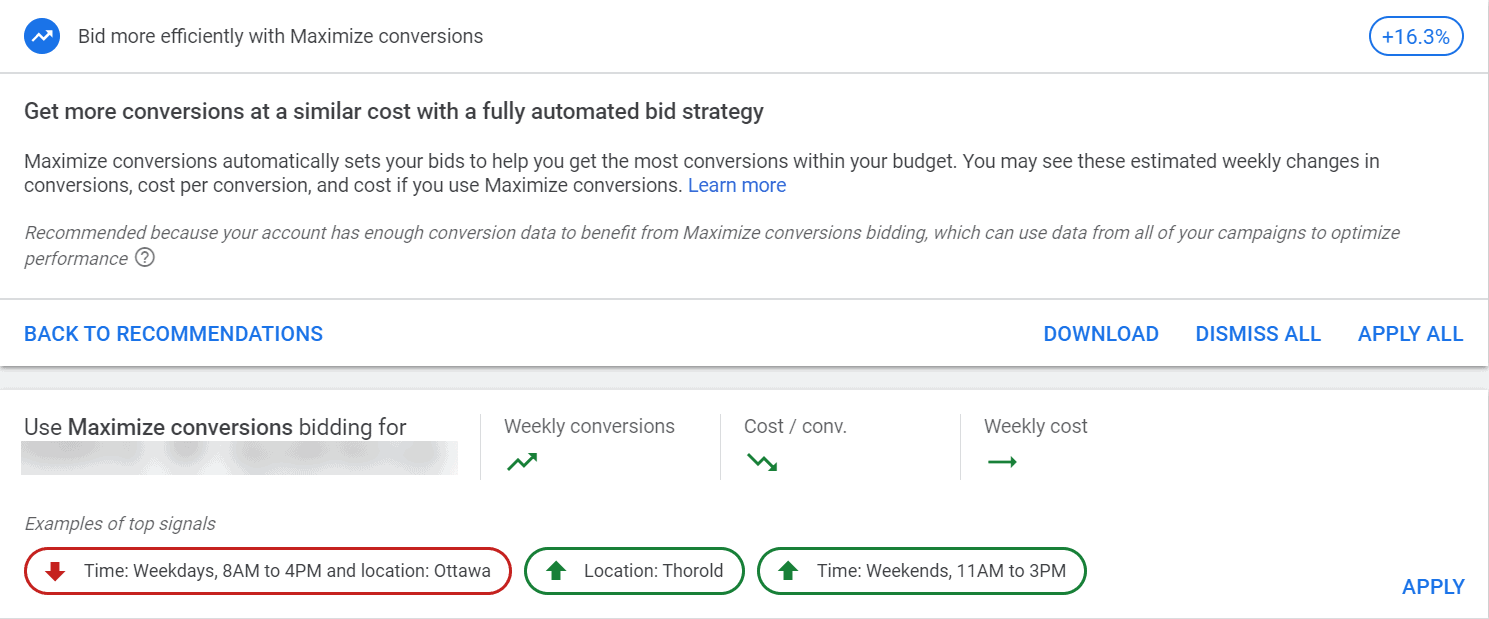
If Google determines that a user is more likely to convert, it will increase your bid to ensure your ad appears higher in the search results to have a better chance of getting a click and ultimately a conversion.
It’s available for all Google Ads campaign types.
Remember that these campaigns are optimized for driving action on your site. Be sure to test and optimize your landing pages to ensure you get the best results.
Stage 3: BOFU – Generate conversions with hot audiences
The hottest users arrive at the Bottom of the Funnel. These are the most valuable prospects since they’re close to converting on your core offer.
At this stage, you want to use Google Ads to close the deal. It’s time to be straightforward and more assertive at pushing for the highest value conversions.
Depending on your business model your end goal can be driving leads or sales.
Use your ad and landing page messaging to address any potential objections and put some pressure with time-sensitive or limited offers.
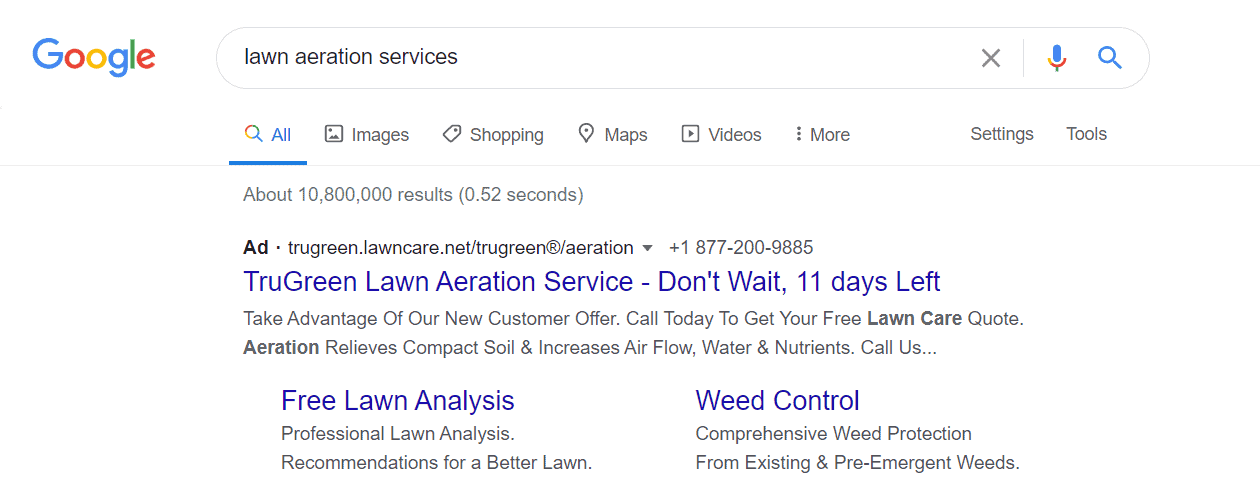
Use ad copy that creates a sense of urgency to nudge hot audiences to take action and convert.
Similar to the MOFU stage, at the Bottom of the Funnel there’ll be two kinds of users to target:
- Users that previously interacted with your ads or website
- Users that search for high buying intent keywords on Google
Those in the first group can be reached with various types of remarketing campaigns. On the other hand, you can capture those in the latter group by using Google search ads.
Since you can directly generate revenue from these campaigns you can afford to spend more and use conversion optimized bidding strategies to acquire BOFU prospects.
a) Optimal Google Ads campaign type for the BOFU stage
The best performing Google Ads campaign types for the BOFU stage are:
- Search campaigns
- Remarketing (Video and Display)
- RLSA ads
1. BOFU Search campaigns
Bottom of the Funnel search campaigns are at the core of Google advertising in general, not just when building a funnel. During the Action stage, potential customers have already made up their minds and are ready to convert.
At this stage, search campaigns are directly responsible for generating high-value conversions like signups and purchases. So, it’s time to bring out the big guns and target keywords that indicate the highest buying intent.
Hot prospects have clearly defined what they need and are actively searching for the right product/service to buy.
Target highly specific keywords that indicate a user is ready to take action.
Such search terms represent transactional keywords like “buy Neutrogena sunscreen” or “get auto insurance online.”
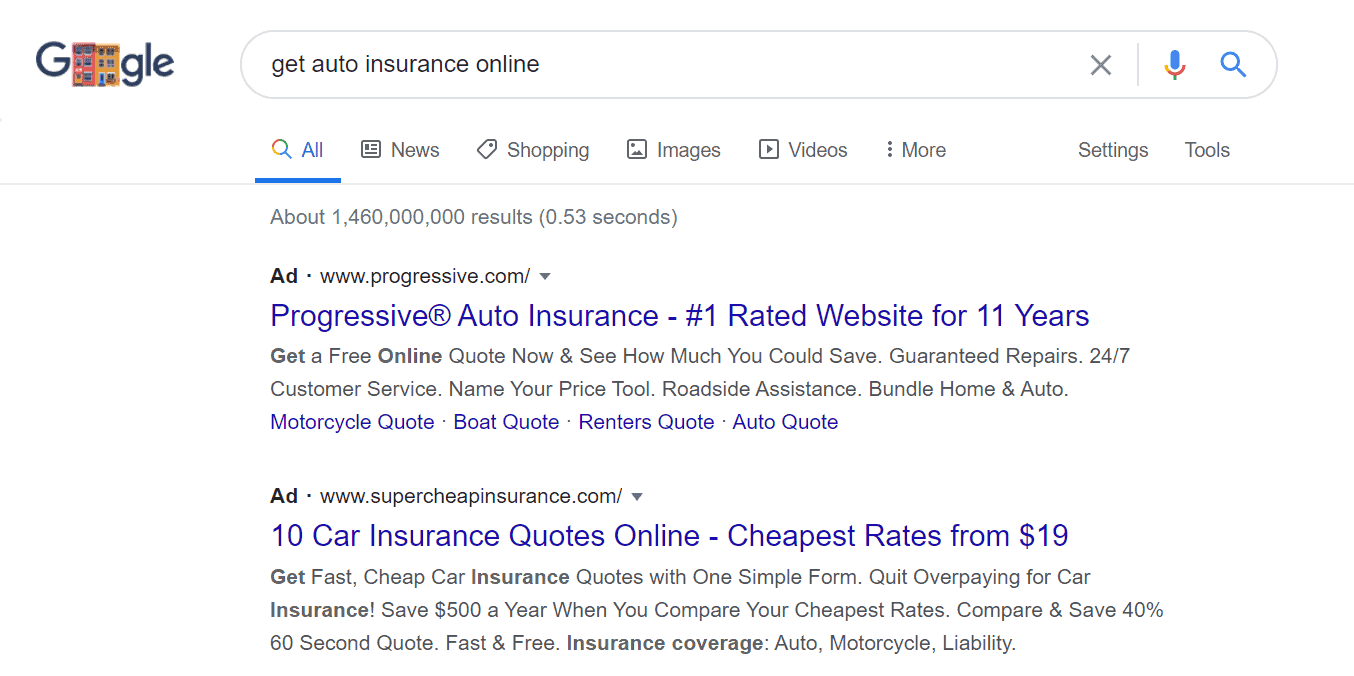
Since these keywords are so close to generating actual revenue for a business, no doubt they’ll be insanely competitive and expensive to bid on.
However, if you follow along and build a full PPC funnel as described, most of these users would have already interacted with you in the earlier stages. These interactions make it much easier and less expensive to reach and convert hot audiences.
And a right combination of targeting, bidding strategy and offer will help you efficiently and effectively convert these searchers into paying customers or high-quality leads.
Search campaign targeting for the Bottom of the Funnel
Bottom of the Funnel keyword targeting includes the following:
- Specific product/service keywords
- Geolocation keywords
- Branded keywords
- Competitor keywords
- Action keywords
Hot prospects’ search terms are more refined and specific and indicate high buying intent.
Someone searching for “ballast-compatible t8 led tube” knows exactly what they need or want and is most likely looking to buy that specific product.
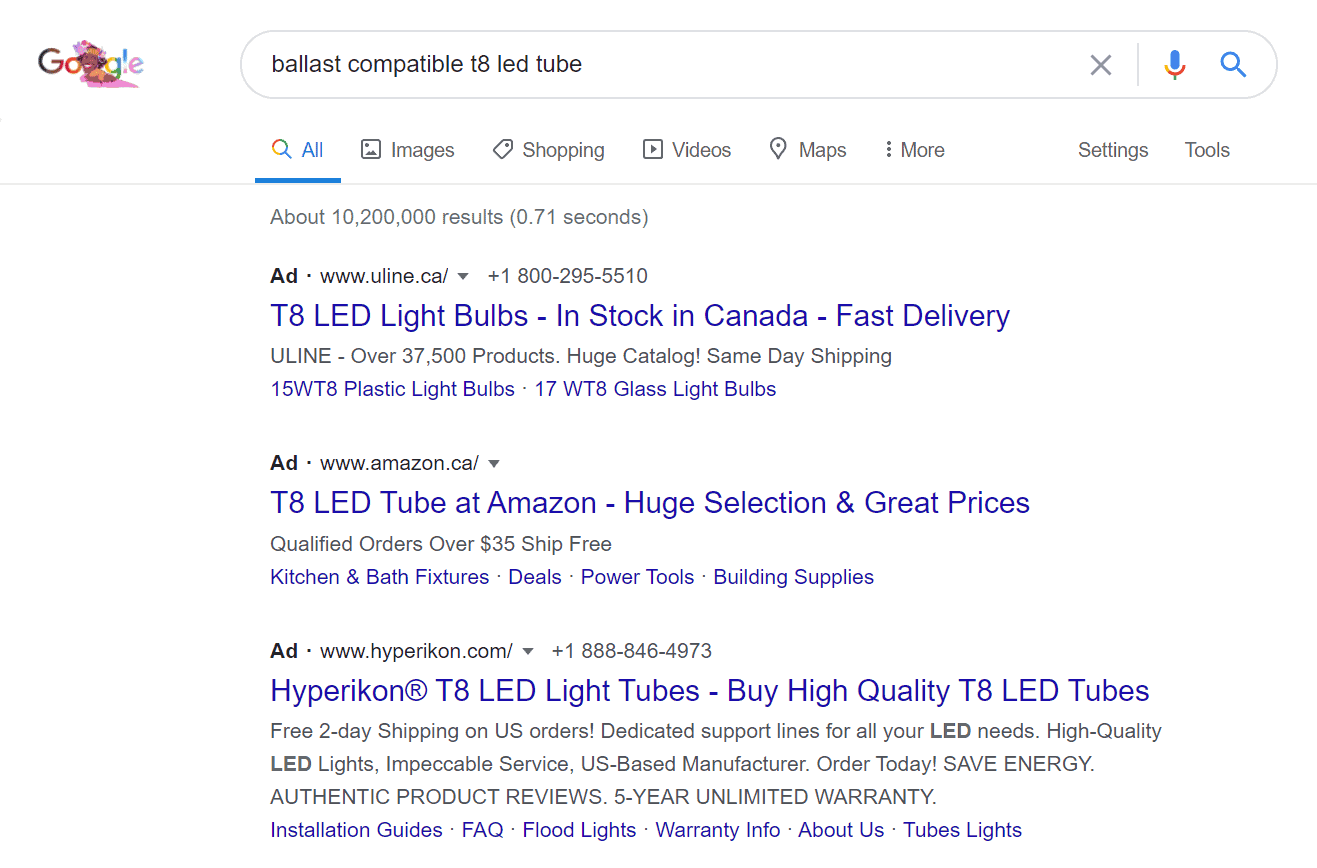
The same goes for someone googling for “day spa near me” or “Italian food delivery Toronto.” Such location-oriented queries indicate a user is ready to get a service or buy a product in their area.
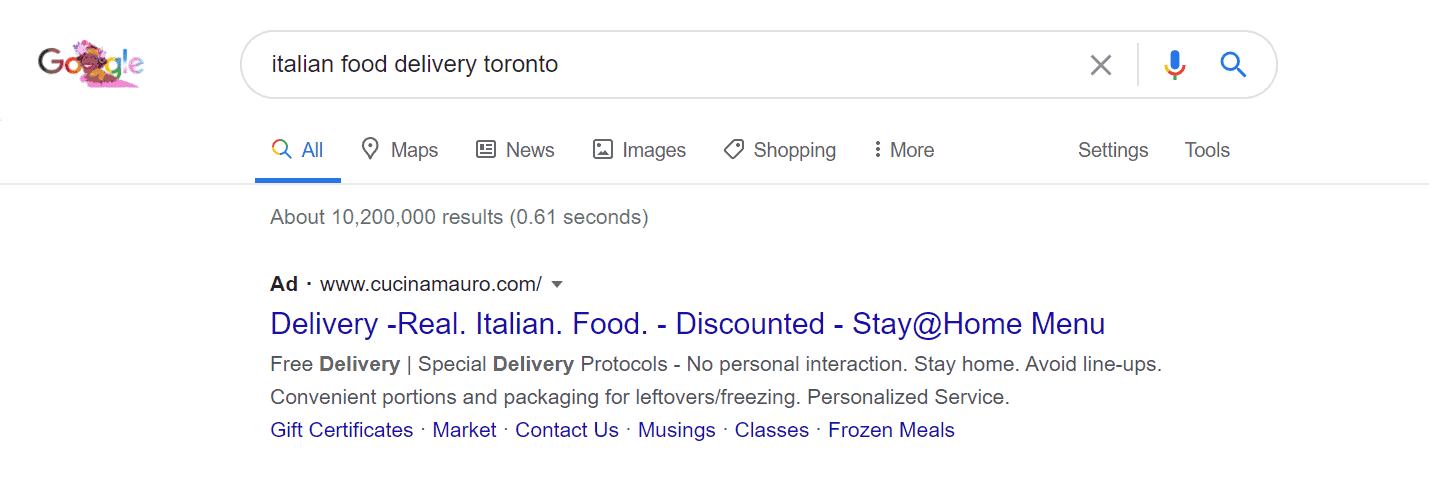
Action keywords also represent BOFU stage queries. These can be regular product/service keywords with the added action modifiers like “buy,” “order online,” “price,” “cheap,” etc.
They signal a prospect’s readiness to go through and buy, order, visit, etc.
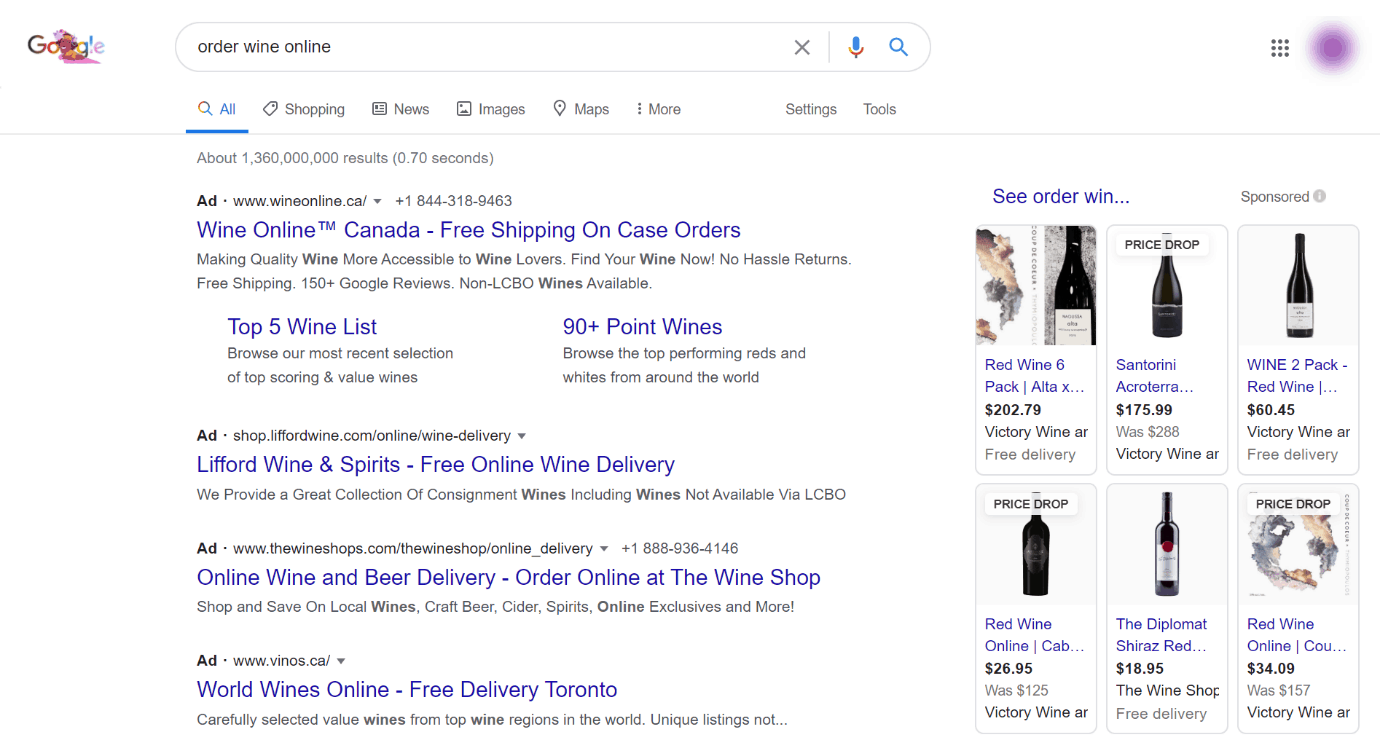
Finally, branded keywords mean a person is searching for an exact brand or business. And since the searcher knows your business name, that’s a clear sign of BOFU stage and high intent.
Also, be sure to own your brand name search results to build a strong online reputation.
It used to be that you didn’t have to run Google Ads for your own business name. However, the competitiveness led to rivals bidding on each other’s branded keywords to pray on potential customers as they’re about to take decisive action.
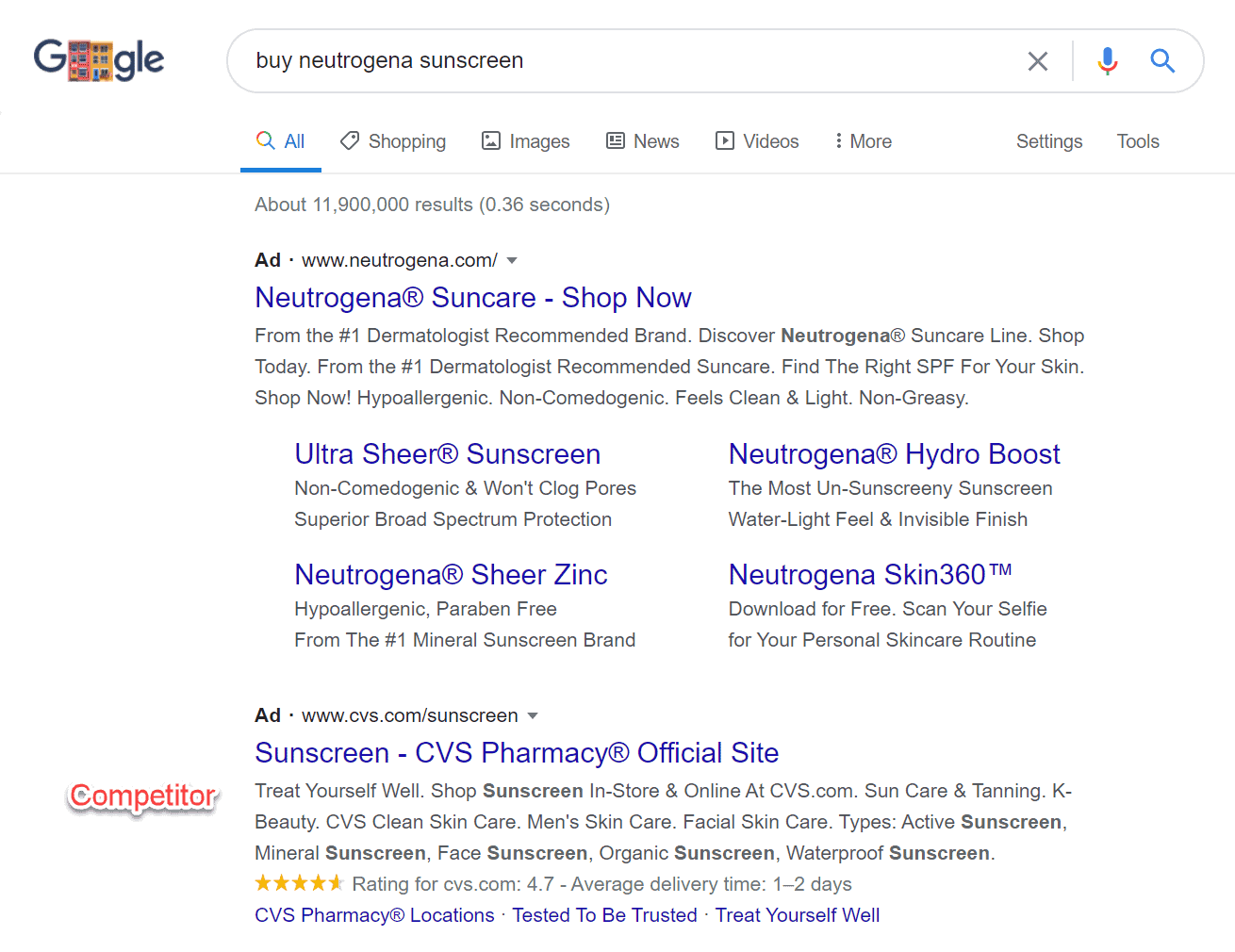
That’s why you should incorporate not only branded keywords to protect your business name but also bid on weaker competitors to steal some of their customers for yourself.
2. BOFU Remarketing campaigns
Remarketing Bottom of the Funnel users includes the following three campaign types:
- Display ads
- Dynamic display ads
- Video ads
Very often BOFU users need an incentive to make the final decision and convert on your offer. That’s why relevant display ads combined with special deals or discounts can incentivize hot audiences to become customers.
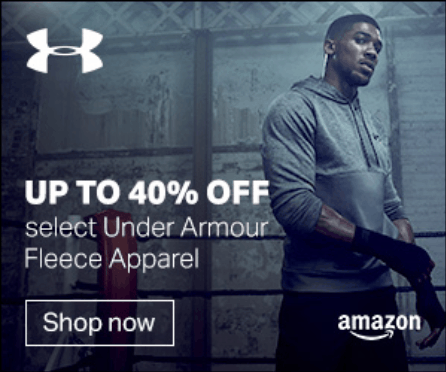
The ads can also focus on shopping perks like free shipping and returns to dismiss any potential buying objections.
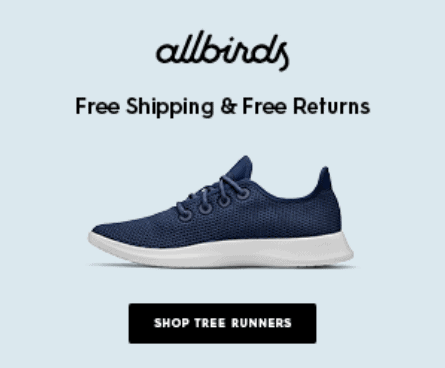
A powerful way to run Bottom of the Funnel campaigns is using Dynamic Remarketing ads.
Dynamic Remarketing Ads on Google are display ads customized for each website visitor, showing content and items related to a user’s previous visits to a website.
So, for instance, if a website visitor checks out LED light products on your website without making a purchase, the next time they browse the internet they’ll see the exact products they viewed on your site.
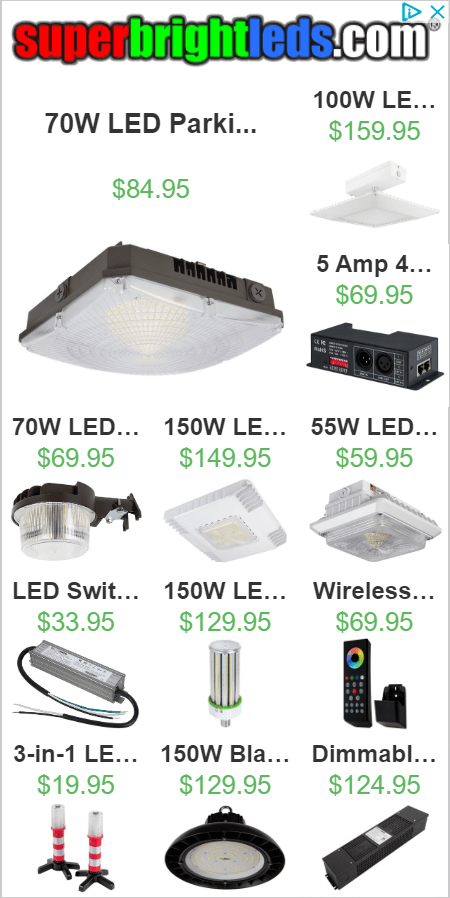
This is an effective ad strategy that helps recover abandoned carts and increase conversions. These are very hot prospects, so a nudge with highly relevant remarketing ads can be enough to encourage them to take action.
For Dynamic Remarketing to work you need to enable the collection of specific attributes or parameters to personalize ads during the Google Ads tag data source configuration.
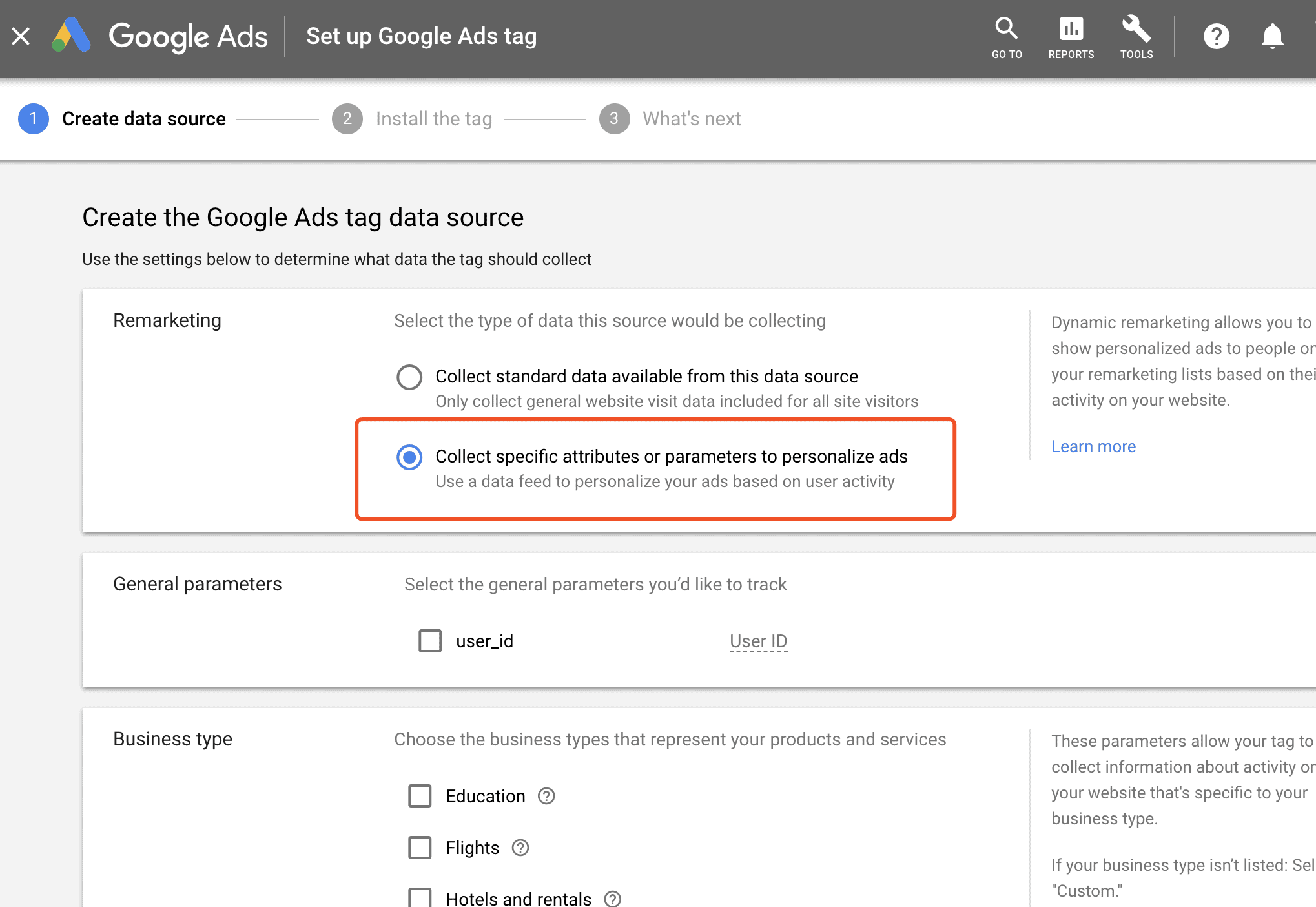
Last but not least, use video campaigns to appeal to hot audiences who are close to converting.
Google video campaigns that work best in the BOFU stage are TrueView for Action campaigns and Shopping campaigns.
TrueView for Action campaigns are similar to traditional TrueView campaigns, but they also come with clickable CTAs below the video, headline text overlays, and end screens to your ads.
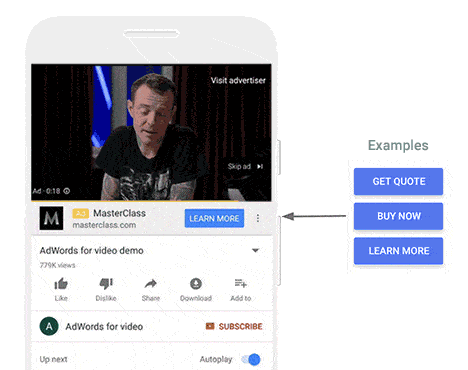
Action ads are optimized for driving people to act. Even if a user skips the pre-video ad, they’ll still see the banner below the video with a CTA that can be clicked, giving your promotion extra visibility.
TrueView Shopping ads can be extremely effective for driving e-commerce sales. These ads feature products from your online store to retarget users below a video description on YouTube.
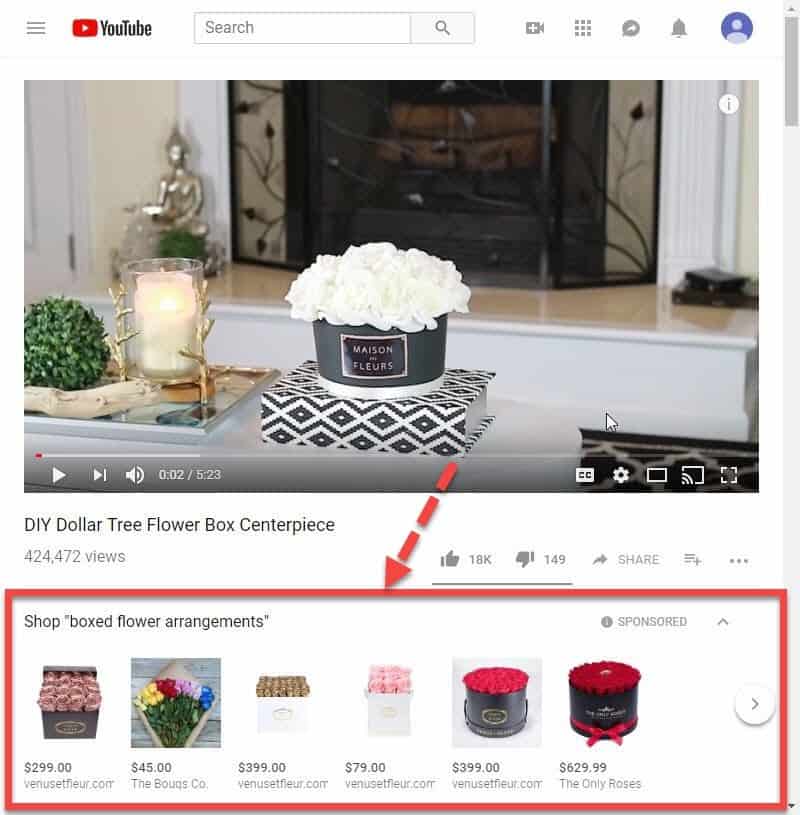
Shopping ads on YouTube can also be set to dynamically show specific videos to users who visited certain products, making the ads extremely relevant to each potential customer.
Remarketing campaign targeting for the Bottom of the Funnel
Optimal targeting options for BOFU Remarketing campaigns can include users who have engaged with videos from earlier funnel stages, those who visited specific pages on your website or even those who signed up for your email list.
For e-commerce, you should remarket to users who recently viewed specific products on your site or added products to their cart but haven’t purchased.
- Visitors to specific key pages
- Leads and subscribers
- Cart abandoners
BOFU remarketing should be more focused, you don’t want any user to see your ads. Instead, set targeting to reach people most likely to convert on your core offers.
For example, you may want to only remarket to users that viewed specific pages on your site, such as your pricing and features pages.
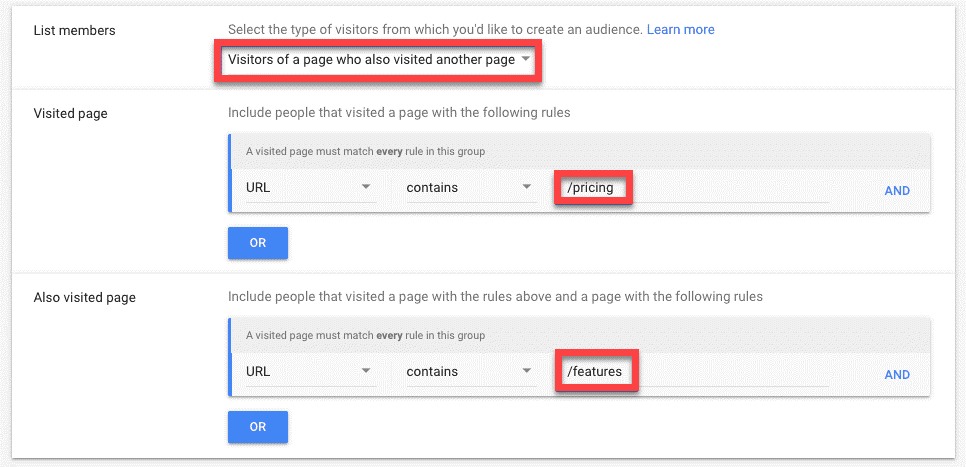
For e-commerce, you can remarket to shoppers that abandoned their cart.
In this case, set the type of visitors to target those the visited one page but did not visit another page. It does sound a bit complicated, so follow this example…
Set the visited page to your cart page and the unvisited page to your order confirmation or thank you page.
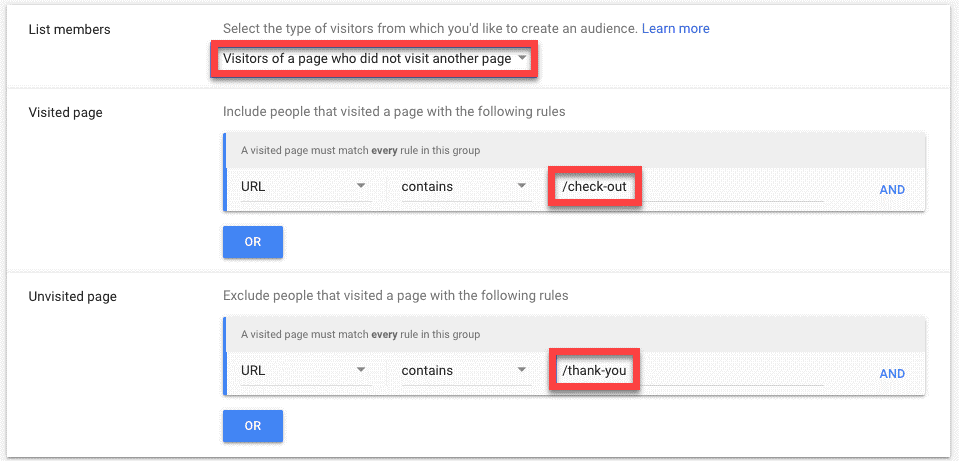
No matter how optimized your checkout flow is, some shoppers will slip through the cracks and leave their cart without purchasing.
Remarketing to cart abandoners is a powerful strategy to get these users back to your site to complete the order.
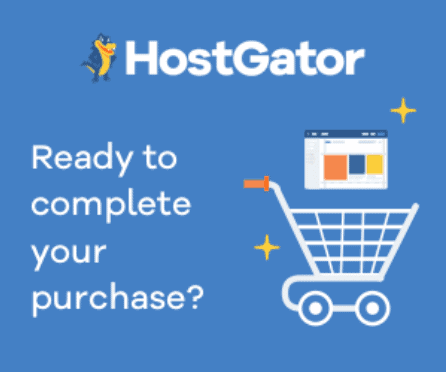
If you’ve collected leads in the previous funnel steps, you can upload a CSV list of email subscribers.
Google will then try to match this data to its users to show highly relevant remarketing ads to help push leads to the ultimate conversion.
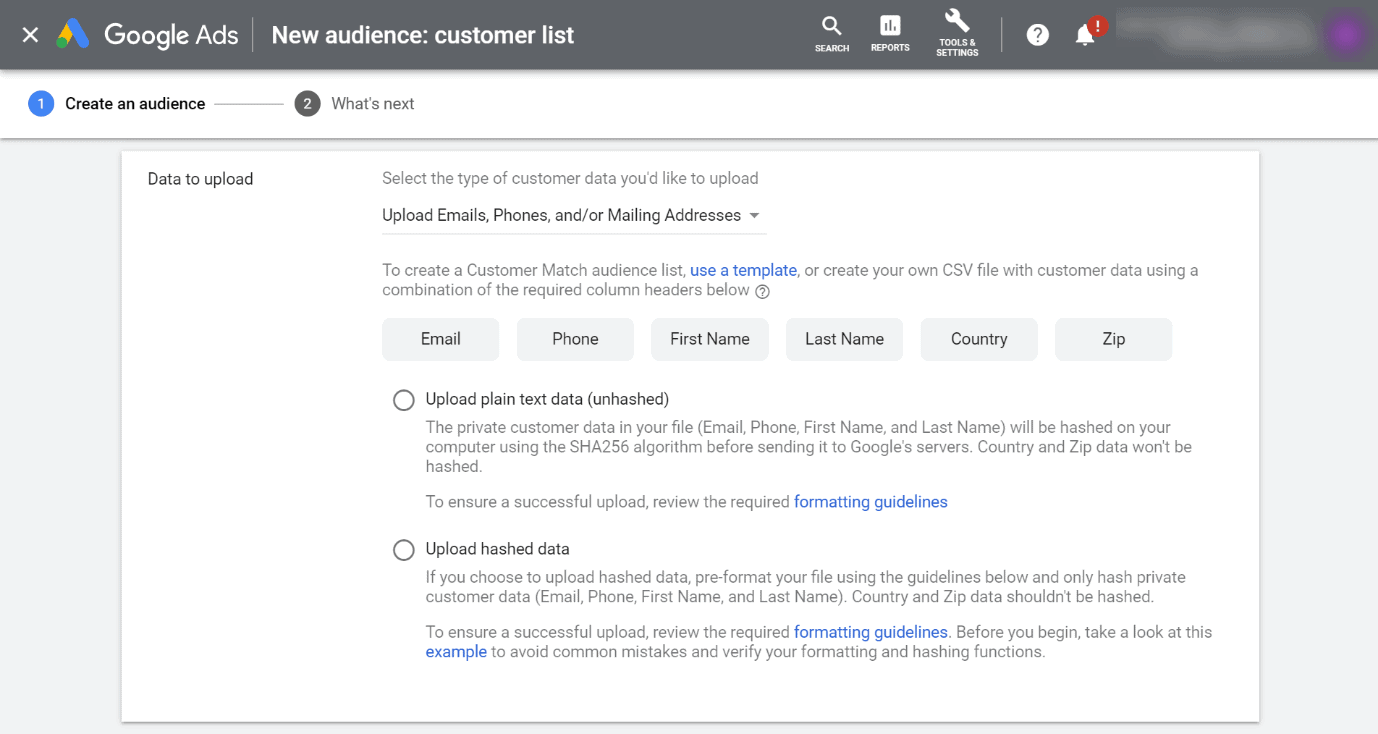
The only challenge is that customer list remarketing (as it’s called in Google) requires good account standing, 90+ days of advertising history and a $50K lifetime ad spend.
Still, it’s definitely worth it. Not only can you remarket to leads, but also existing customers to increase loyalty and lifetime value, as well as reach new audiences similar to your quality leads or customers (Lookalike audience).
3. RLSA campaigns for the BOFU stage
Remarketing Lists for Search Ads (RLSA) is a combination of remarketing and search campaigns.
RLSA essentially allows you to tailor Google search campaigns based on if a user previously visited your website as well as the pages that the user viewed.
When prospects who already visited your site search for relevant BOFU keywords, your ads show up again with increased bids and a higher chance of bringing these hot users back to your site for conversion.
For example, let’s say someone who already visited your site goes back to Google using a more refined keyword with high buying intent. RLSA can help ensure your ads are on top, helping you capture potential customers when they’re ready to take action.
If a person searching for “how to clean teeth with braces” lands on your website, you can use RLSA to increase bids by 50% and ensure your ads appear on top when they google a more specific term like “professional electric toothbrush for braces.”
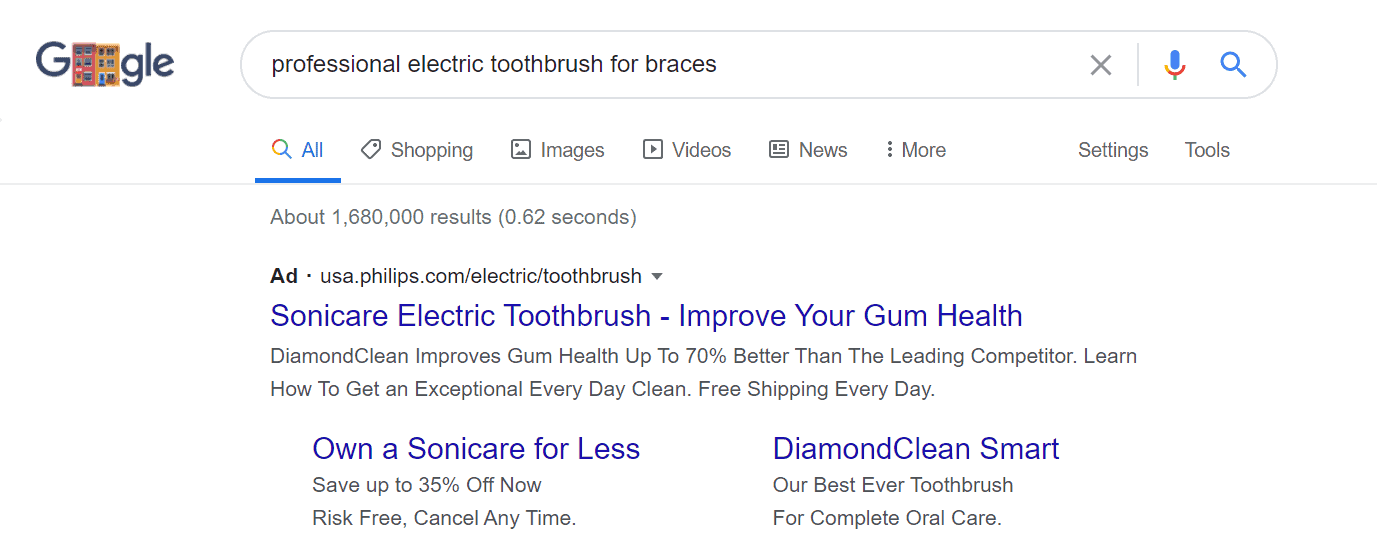
Be sure to pair your RLSA ads with irresistible offers like special discounts to ensure as many clicks possible result in conversions.
With RLSAs you can tailor search campaigns to target more qualified and valuable users who are already aware of your business. This can lead to efficient ad spend, higher conversion rates and ultimately a better ROI.
Unlike standard remarketing, RLSAs don’t automatically show search ads to users just because they are on your remarketing list. The users need to be actively searching on Google using the keywords you are bidding on within your search campaigns.
RLSA campaign targeting for the Bottom of the Funnel
RLSA targeting works by setting both keywords, like in regular search campaigns, as well as audiences, like in other remarketing campaigns.
You can set your keyword targeting in the standard PPC campaign setup.
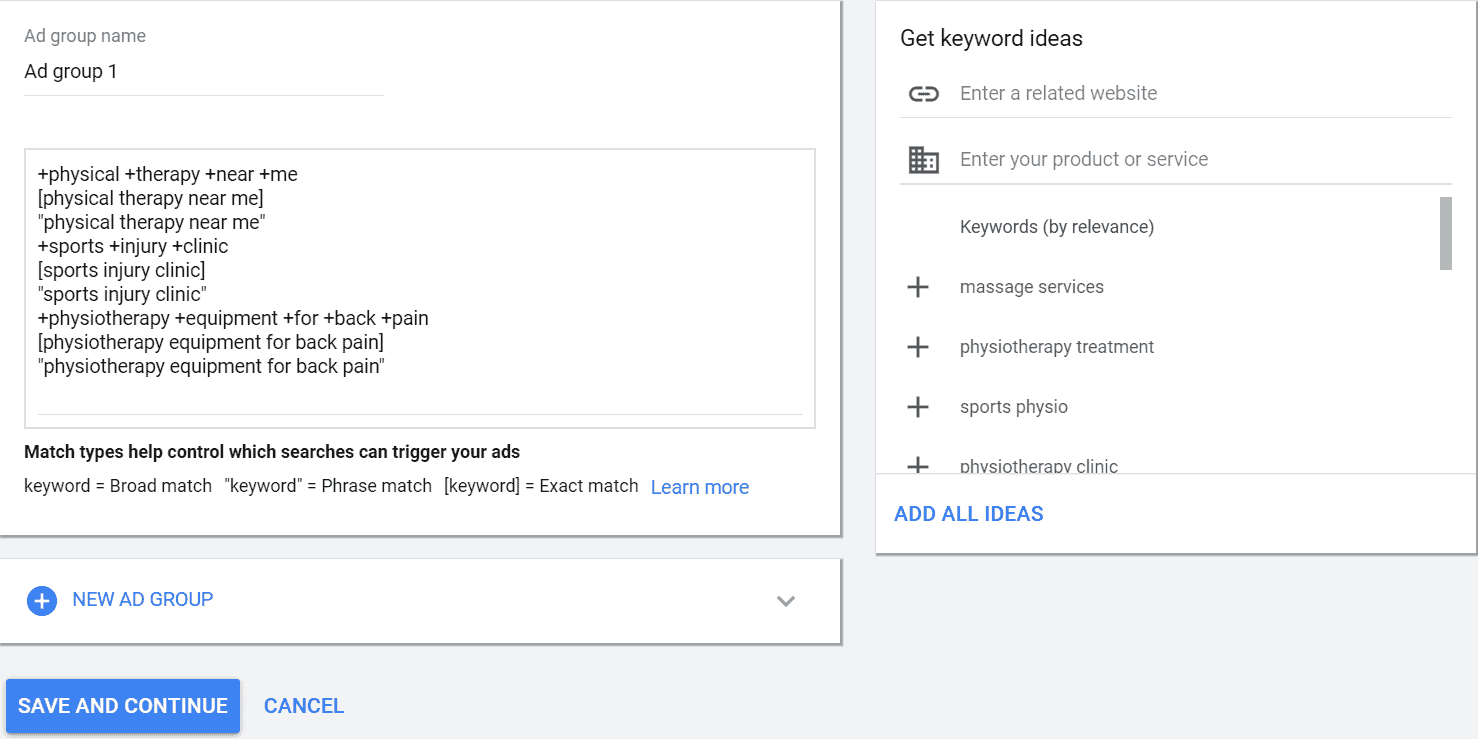
The other step is to add audiences based on how they’ve interacted with your business. Include your existing website visitors and exclude all converters.
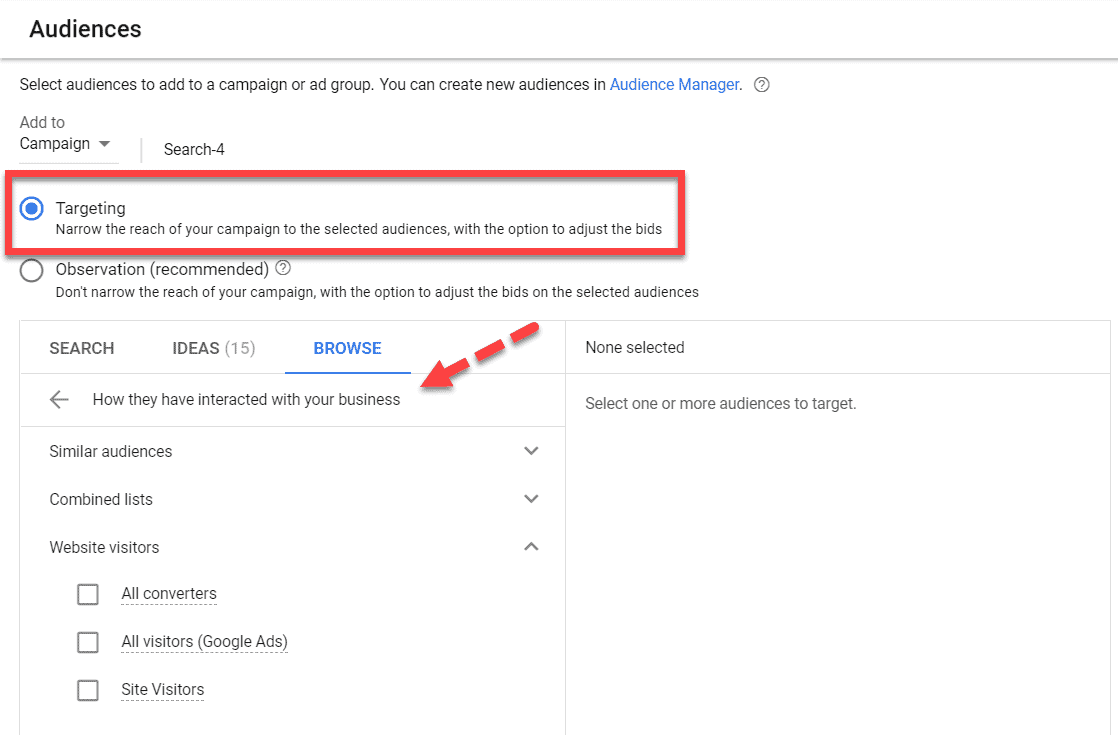
Also, remember to set the toggle to Targeting mode to narrow the reach of this campaign to only your remarketing audience.
Finally, for best results target keywords with high buying intent.
RLSA ads do mean that you bid higher than normal, so you’ll want to maximize the conversions you get from this campaign.
b) The perfect content and offer for hot audiences
The bottom of the Funnel is where you’re trying to close the deal and drive highest-value conversions. Focus your Google Ads on pushing hot audiences to take action on your well-designed website optimized for conversions.
At the BOFU stage, it’s time to highlight the value of your deal. Ideally, your ad copy should include things like:
- Price (especially if it’s an attractive price)
- Free shipping
- Fast delivery
- Special deals and discounts
- Financing options
- Free gift
- Social proof
- Sense of urgency
- Risk-free (guarantee) purchase, etc.
Be sure to address any objections and entice users to act immediately.
If the price is a factor, offer up discounts or easy financing options.
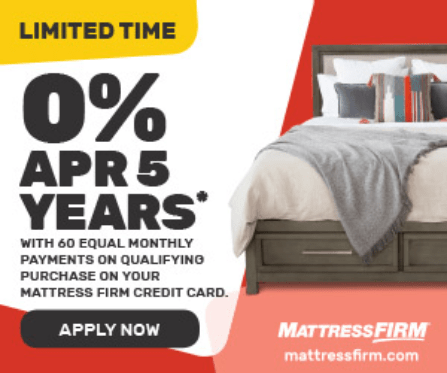
Reinforce buyer’s decision with things like free shipping, risk-free purchasing, or easy returns.
Social proof can also help potential customers feel more comfortable with their decision. Use rating stars, testimonials or awards and recognitions to help them pull the trigger and buy or sign up.
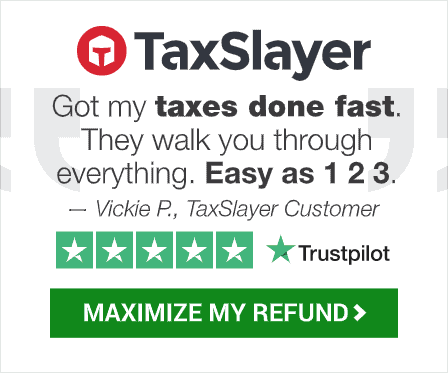
Put some pressure on with scarcity and urgency triggers. Avoid allowing potential customers to overthink your offer.
Use special, limited-time deals to persuade prospects to convert now or miss out.

Your target audience is as hot as they’ll ever be, don’t let them hesitate.
Finally, you can also put a cherry on top with free gifts with every purchase to sweeten the deal.
c) Best Google Ads bidding strategies for the BOFU stage
BOFU is the action stage. Everything is laser-focused on high-value conversions. Your bidding should also match the value of the actions you want to drive.
That’s why in the BOFU stage you need bid high to ensure you outcompete everyone else for those hot prospects.
This is the time to make the most out of your ad budget to drive conversions. And you need to capture those leads and sales as efficiently as possible to maximize profits and ROI.
That’s why it’s best to use the following two automated bidding strategies for your Bottom of the Funnel PPC campaigns:
- Target CPA for lead gen
- Target ROAS for e-commerce
Target CPA is a fully automated smart bidding strategy that adjusts bids to help get as many conversions as possible at (or below) your target cost-per-action (CPA).
Your CPA is the amount of money you can afford to spend on acquiring one conversion (customer or lead).
For example, if you choose a Target CPA of $35, Google Ads will automatically set your bids to try and get you as many conversions at or below $35 on average.
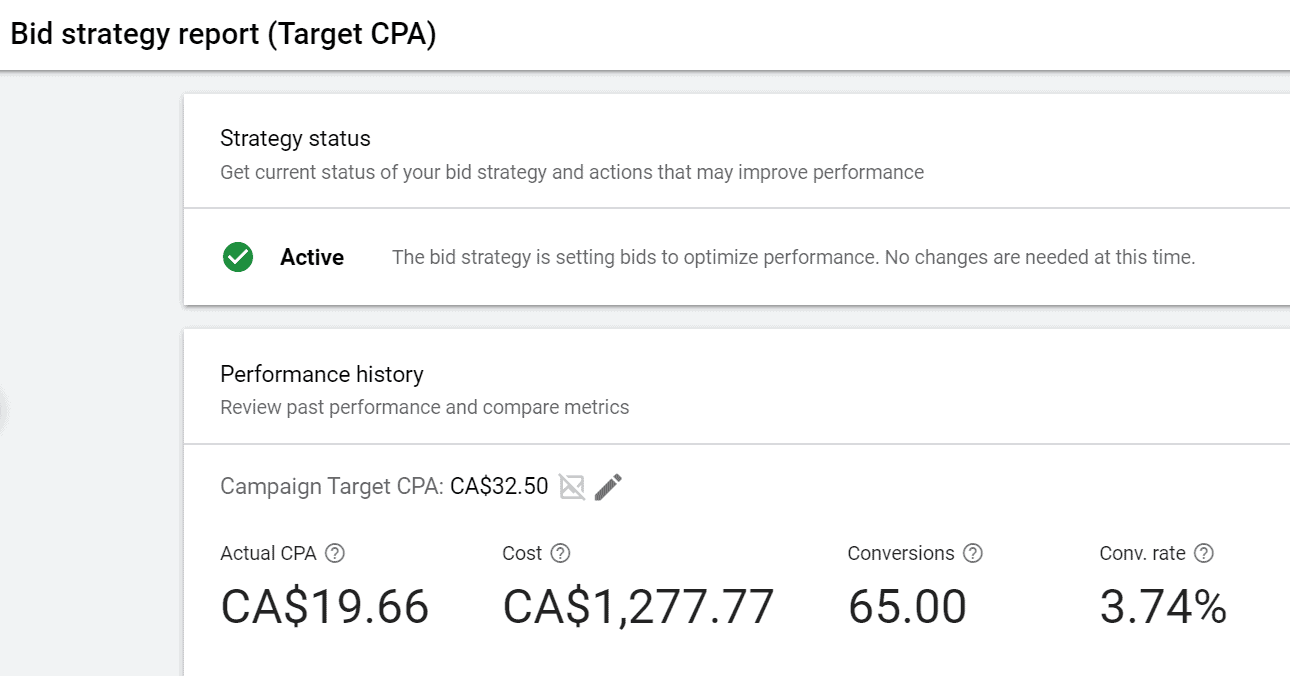
Target CPA works great for both lead generation and e-commerce websites. However, it may be more useful for businesses that want to generate leads.
Online stores can rely on the next bidding strategy.
Target ROAS is also a smart bidding strategy that lets you bid based on a target return on ad spend (ROAS). It tries to maximize conversion value (%) based on the return you expect from your advertising.
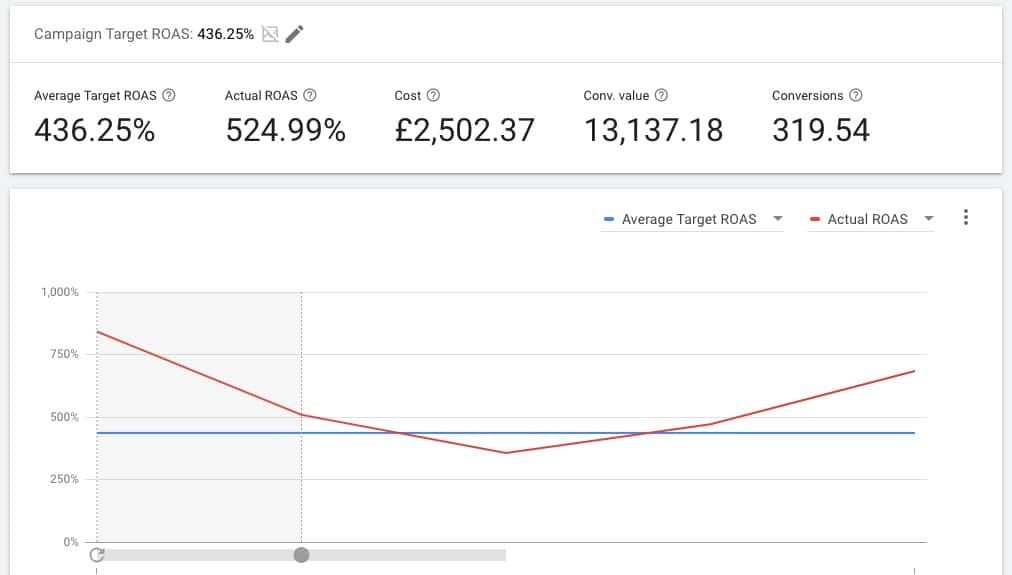
As amazing as this sounds, it does take a bit of math to determine a profitable Target ROAS.
For example, if your profit margin is 50%, your break-even ROAS would be 200%.
Break-even ROAS = 1 / Profit Margin % = 1 / 50% = 200%
In that case, you’ll want to set your Target ROAS higher than 200% to be able to make a profit.
When you factor in your COGS and other expenses, you’ll derive a profitable Target ROAS which should be around 400-500%.
Keep in mind that it’s highly recommended for your daily budget to be 10-20X your Target CPA or ROAS. This allows Google’s machine learning to experiment and learn to find the right patterns that lead to the highest conversion performance.
SECRET PRO TIP: If you have a high converting landing page or e-commerce store, you can get away with lower advertising cost in the BOFU stage by using Max Clicks bidding strategy. It will focus on utilizing your budget to drive the highest amount of traffic at the lowest cost. Be sure to test if your site can convert prospects at a better rate than using other bidding strategies.
Conclusion
Google Ads funnel is the ultimate PPC strategy that maximizes the ROI of your ad campaigns.
It does so by efficiently using your advertising budget to attract scores of new prospects for cheap, then gradually turning up the heat with the right ad messaging and offers that resonate at each step.
It all comes down to setting up the right campaign structure in line with your typical customer journey.
Choose the right targeting, offers and bidding strategy to match the temperature of potential customers and guide them until the ultimate conversion.
Now, I know building a funnel like this can get pretty overwhelming and easy to mess up.
So, if you need professional help, reach out to us and find out how we can build a perfect Google Ads funnel for your business.
And, as always, any comments or questions are welcome, so keep ‘em coming.

